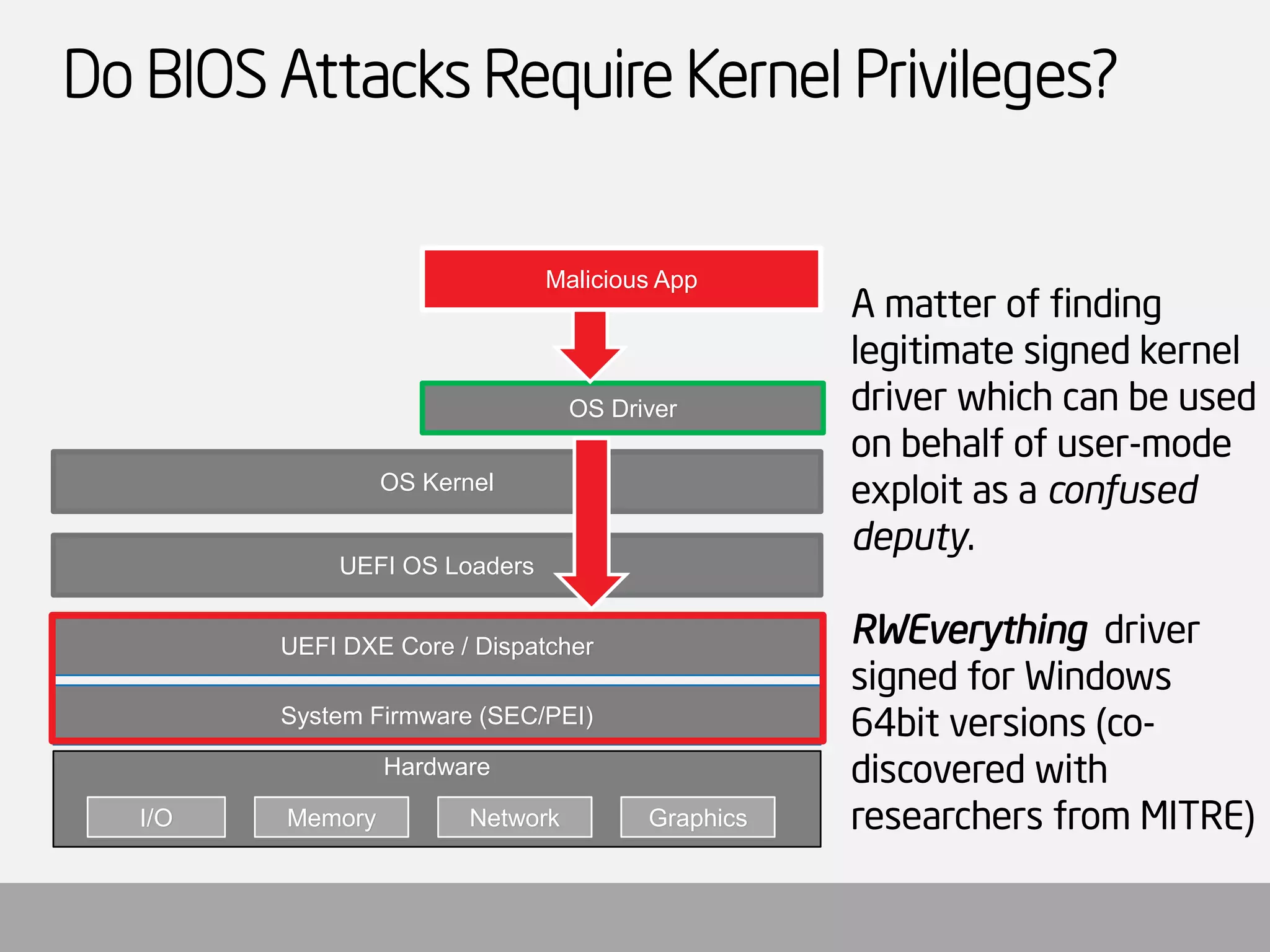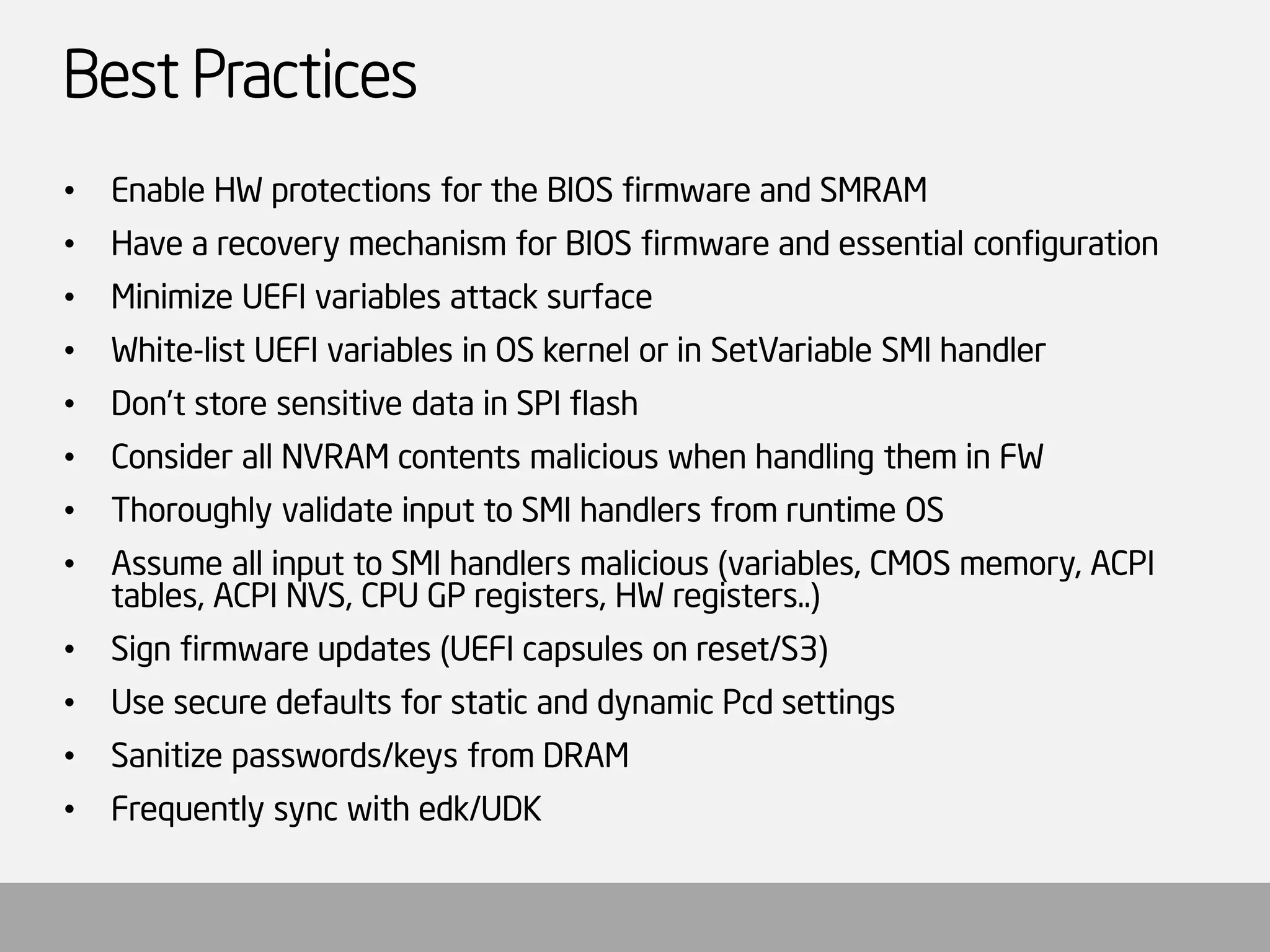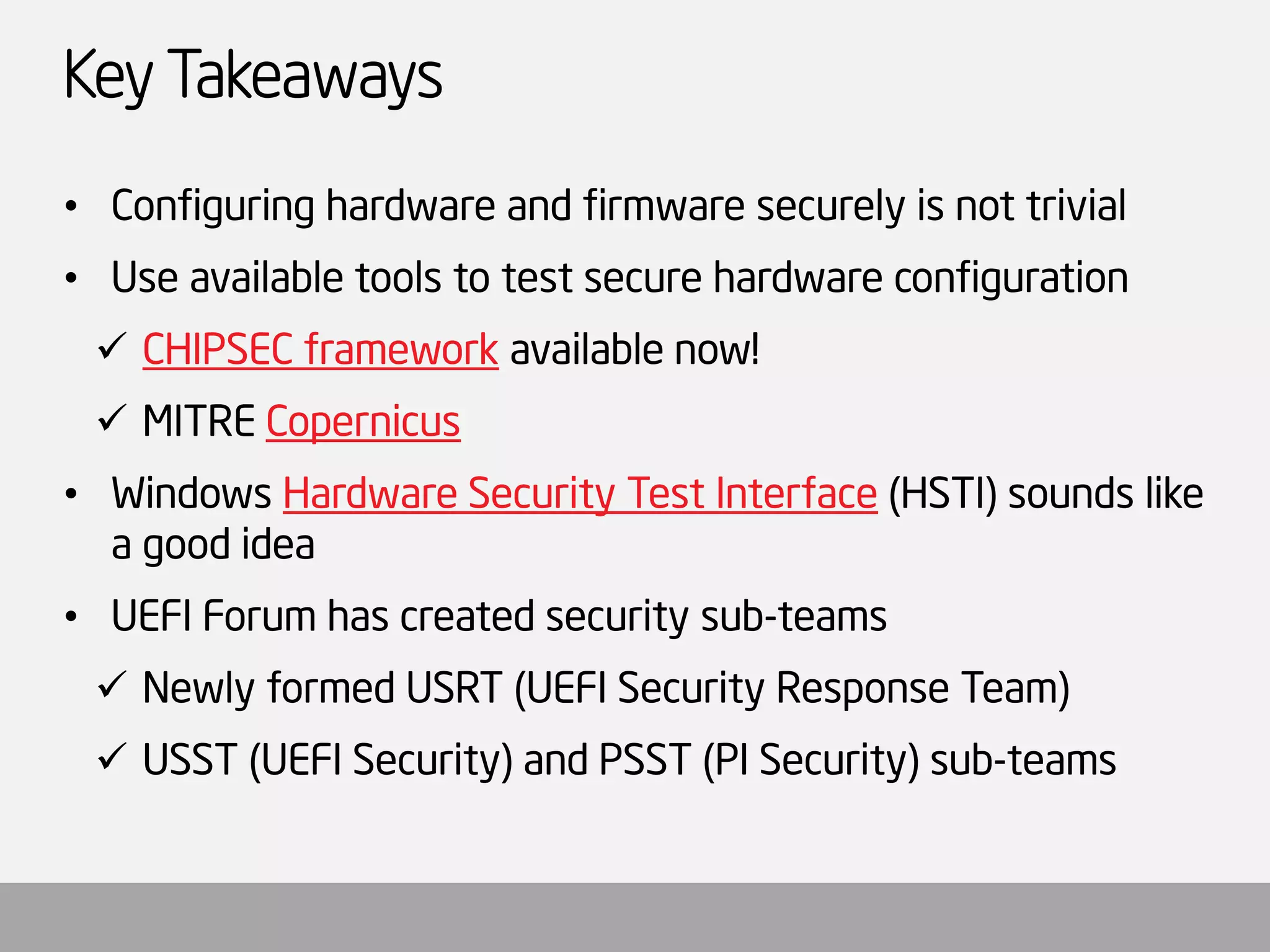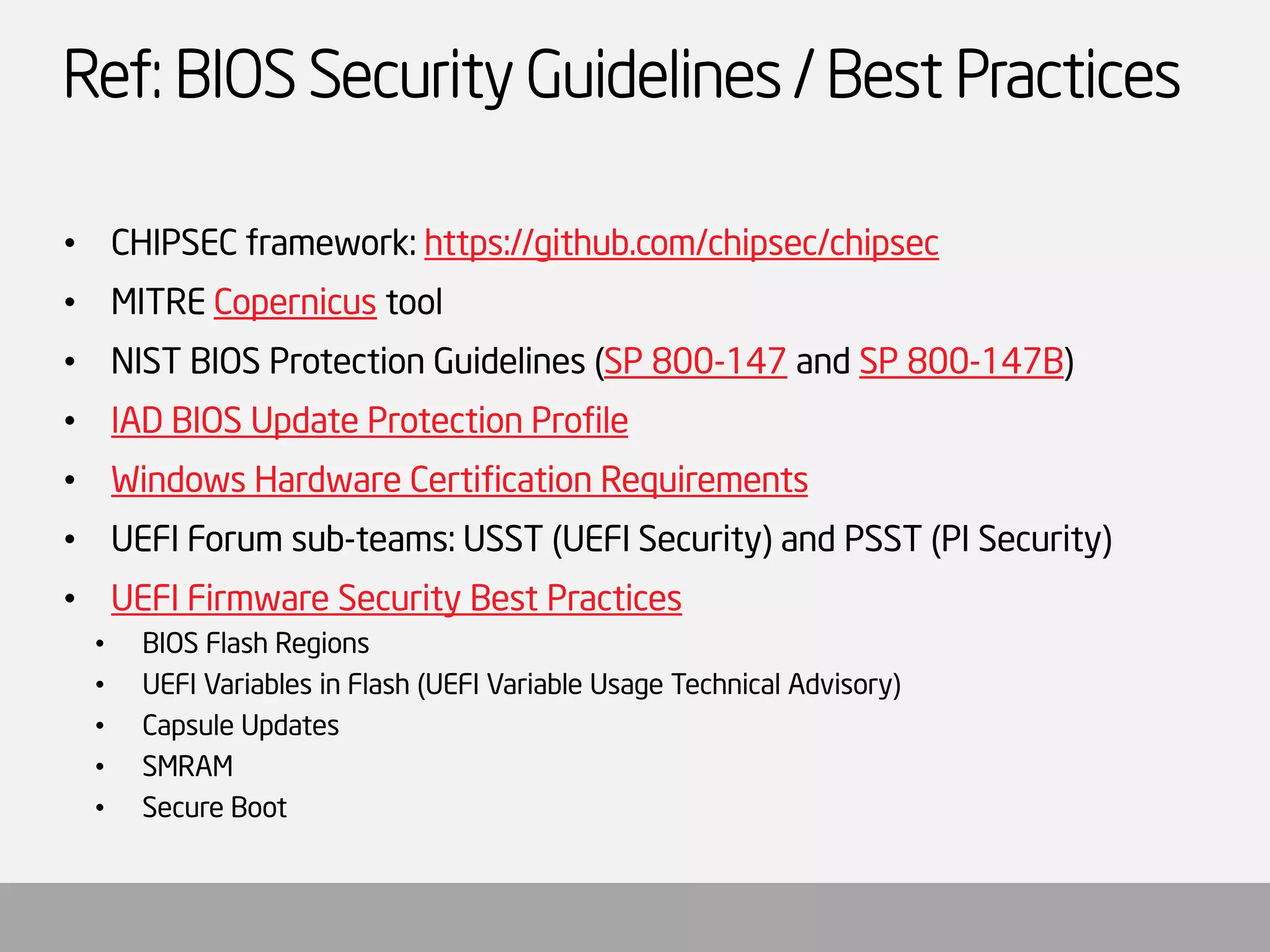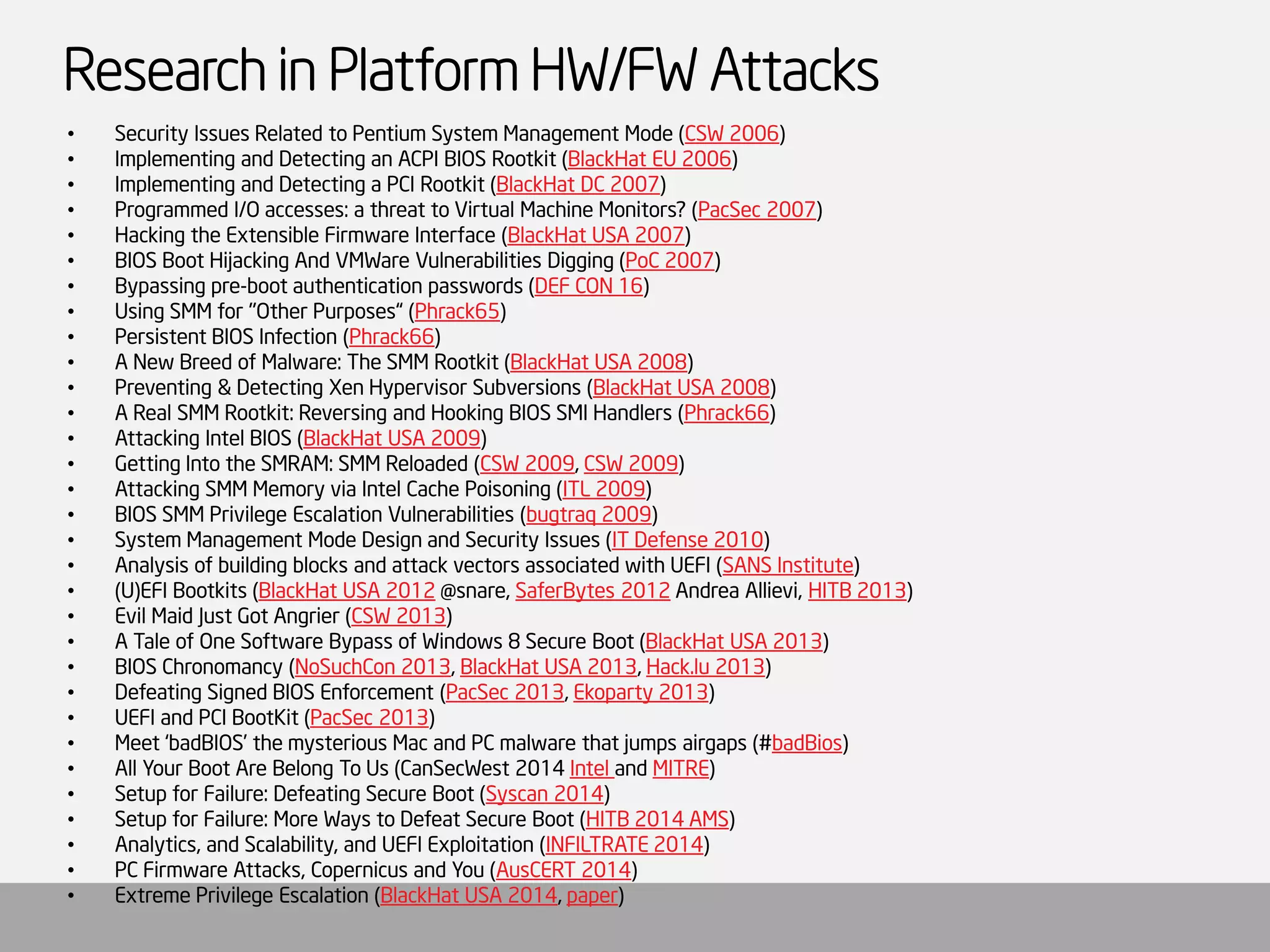This document summarizes several attacks against platform firmware and secure boot. It describes attacks that modify the platform key in NVRAM to disable secure boot, modify the image verification policies to bypass signature checks, exploit confusion between PE and TE file formats to skip signature verification, and corrupt the "Setup" UEFI variable to potentially brick the system. The attacks demonstrate vulnerabilities in how some firmware implementations store and handle sensitive secure boot configuration data in non-volatile variables.
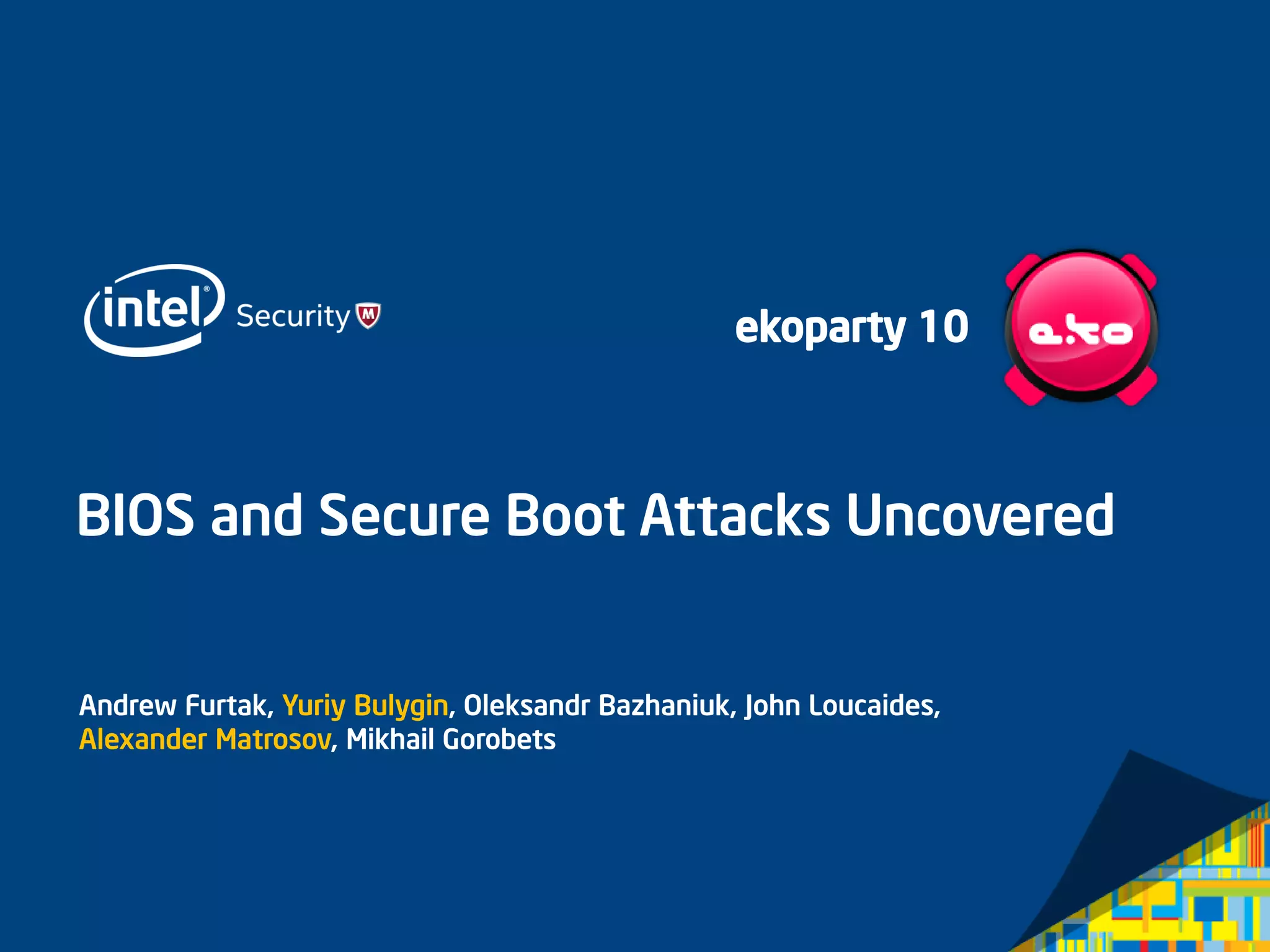
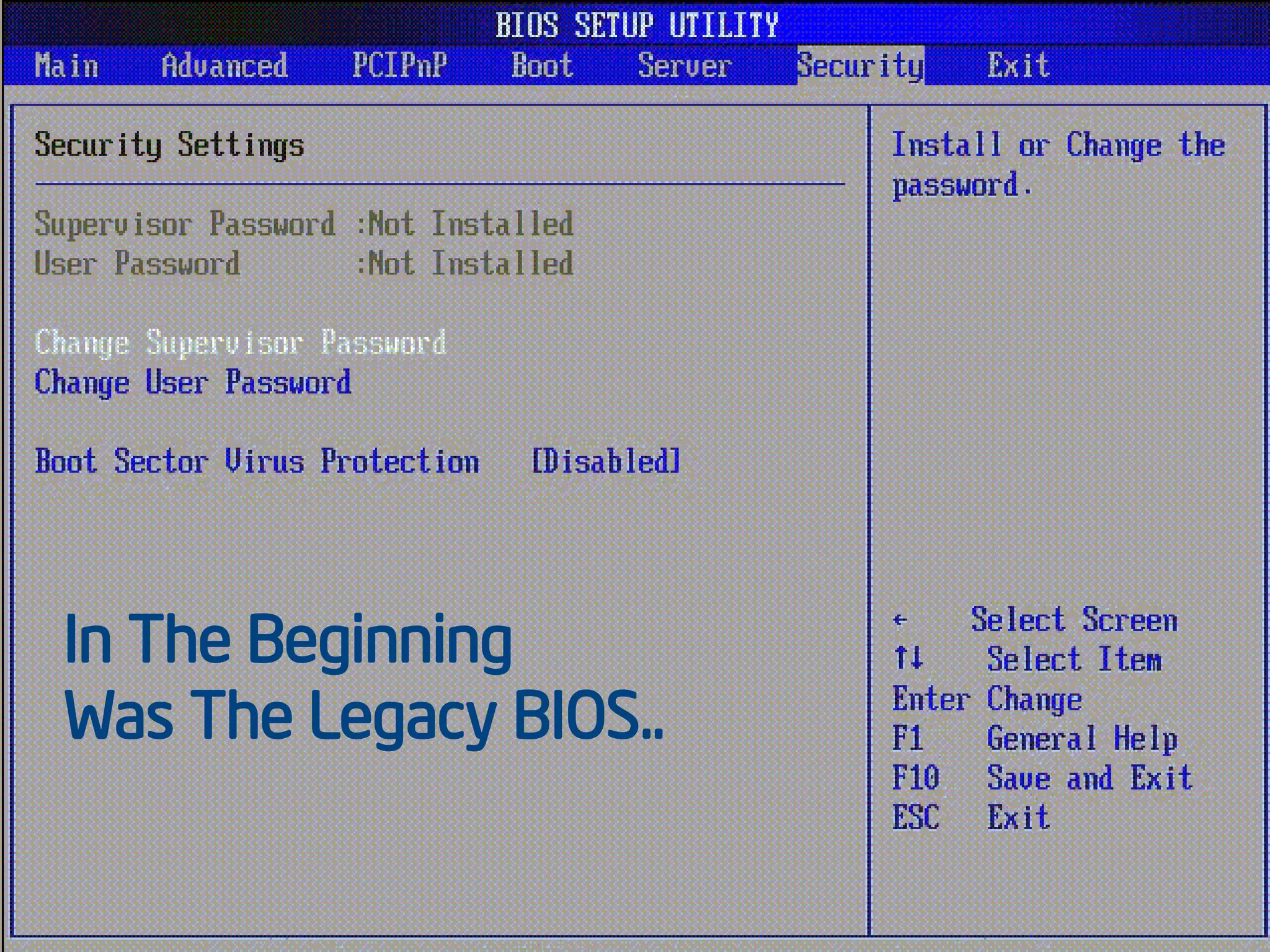

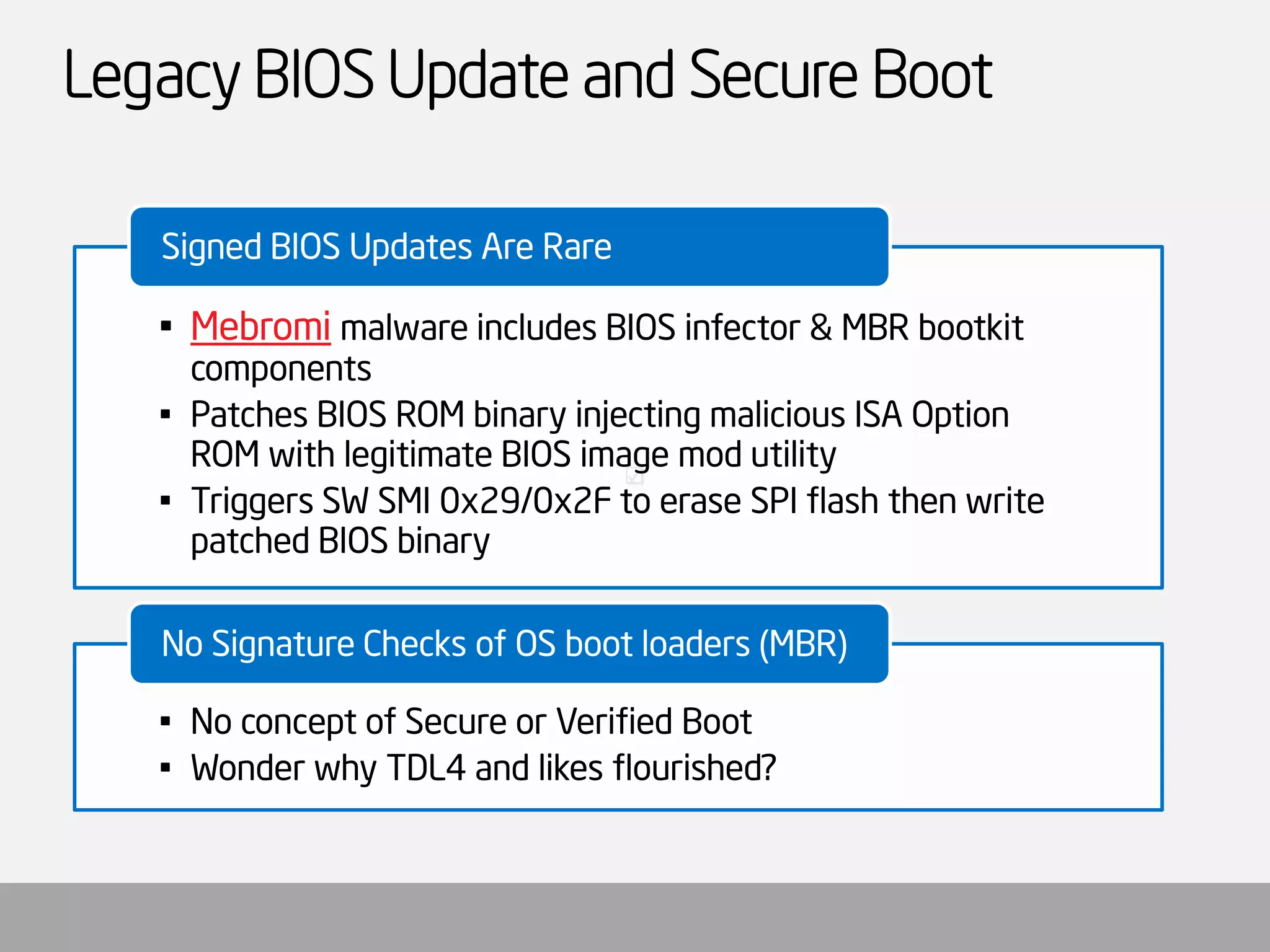
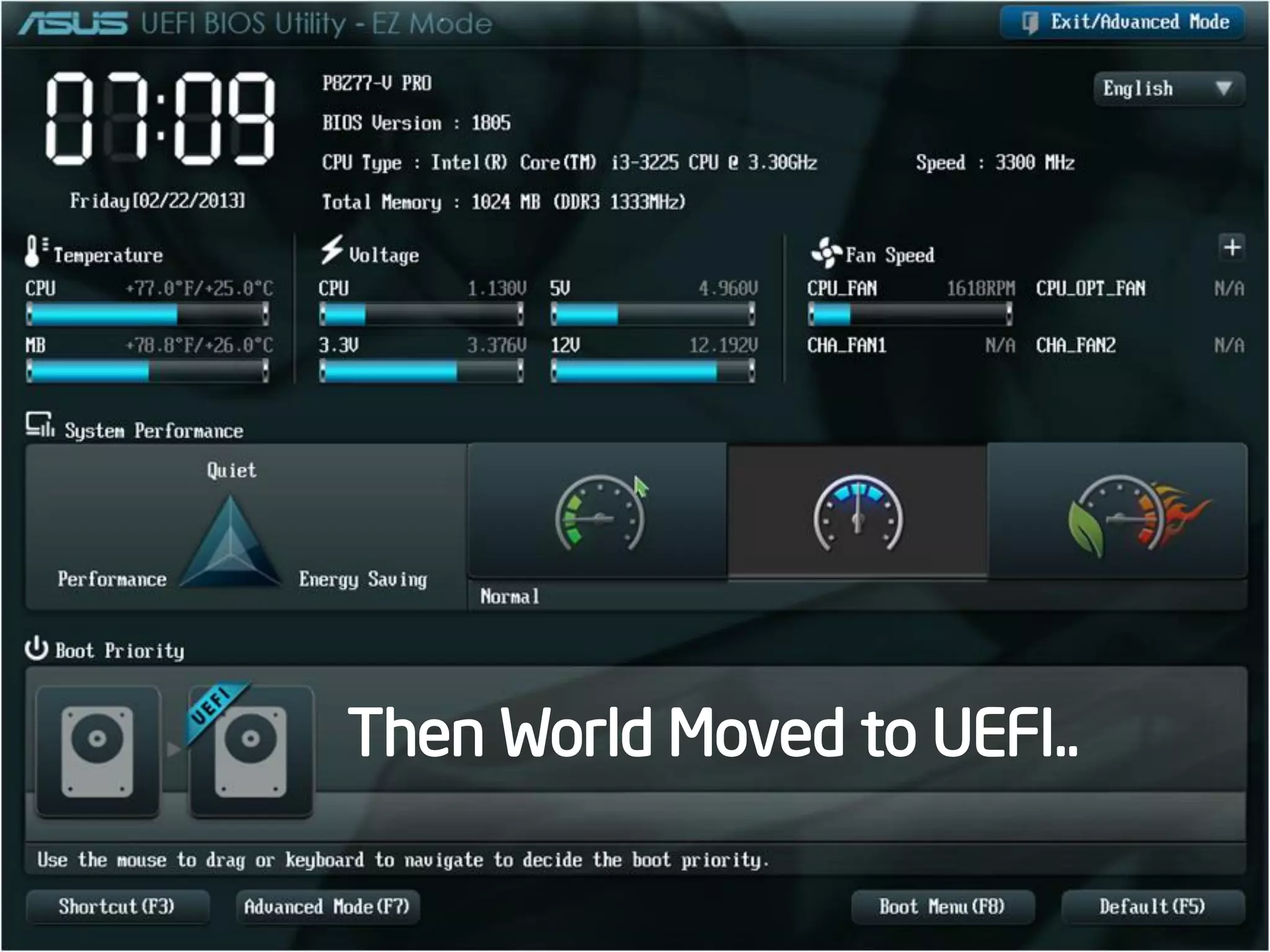
![UEFI [Compliant] Firmware
SEC
Pre-EFI Init (PEI)
Driver Exec Env(DXE)
Boot Dev Select (BDS)
Runtime / OS
S-CRTM; Init caches/MTRRs; Cache-as-RAM (NEM); Recovery; TPM Init
S-CRTM: Measure DXE/BDS
Early CPU/PCH Init
Memory (DIMMs, DRAM) Init, SMM Init
Continue initialization of platform & devices
EnumFV, dispatch drivers (network, I/O, service..)
Produce Boot and Runtime Services
Boot Manager (Select Boot Device)
EFI Shell/Apps; OS Boot Loader(s)
ExitBootServices. Minimal UEFI services (Variable)
ACPI, UEFI SystemTable, SMBIOS table
CPU Reset](https://image.slidesharecdn.com/biosandsecurebootattacksuncoveredeko10-141213185452-conversion-gate01/75/BIOS-and-Secure-Boot-Attacks-Uncovered-6-2048.jpg)
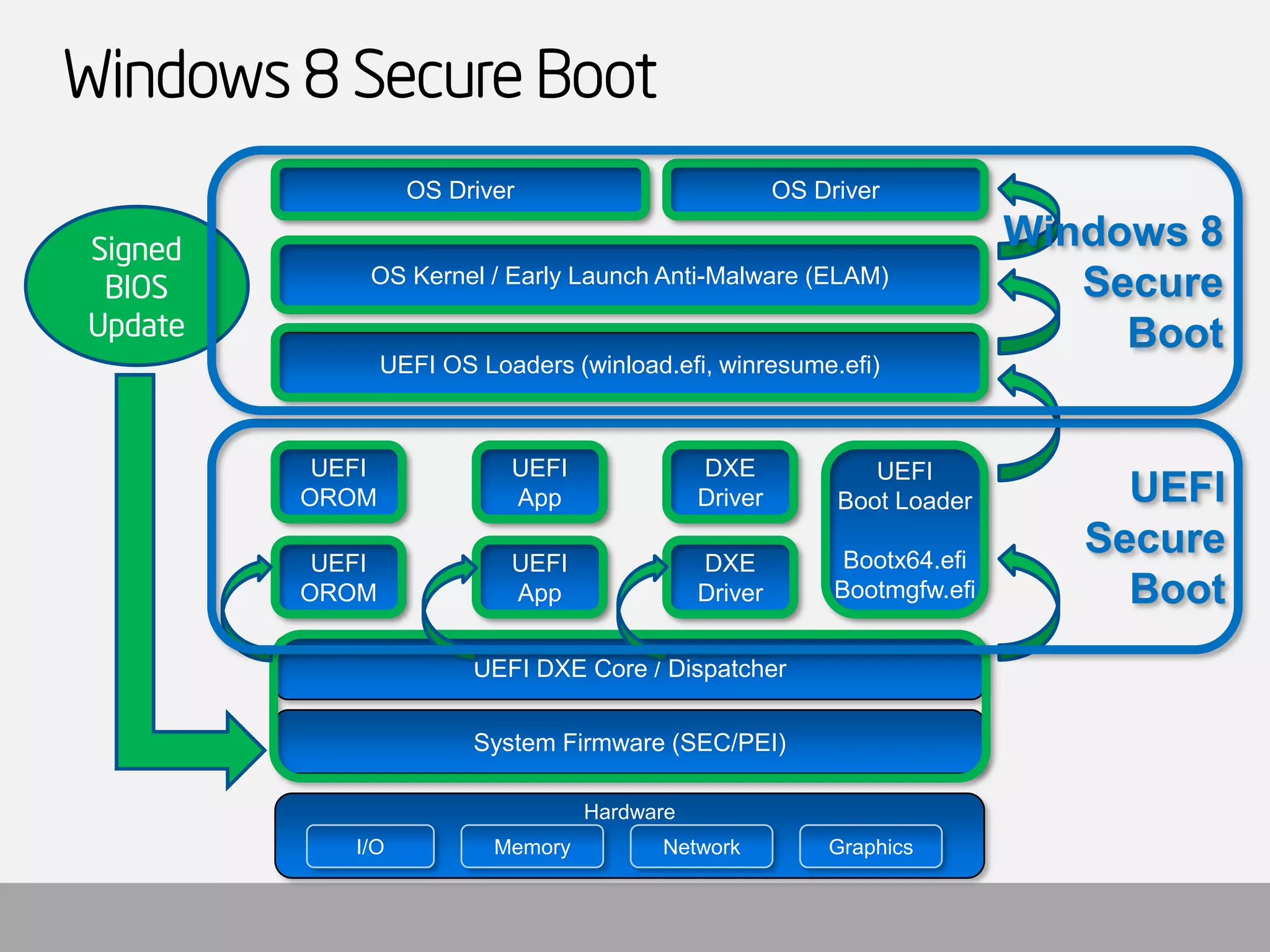
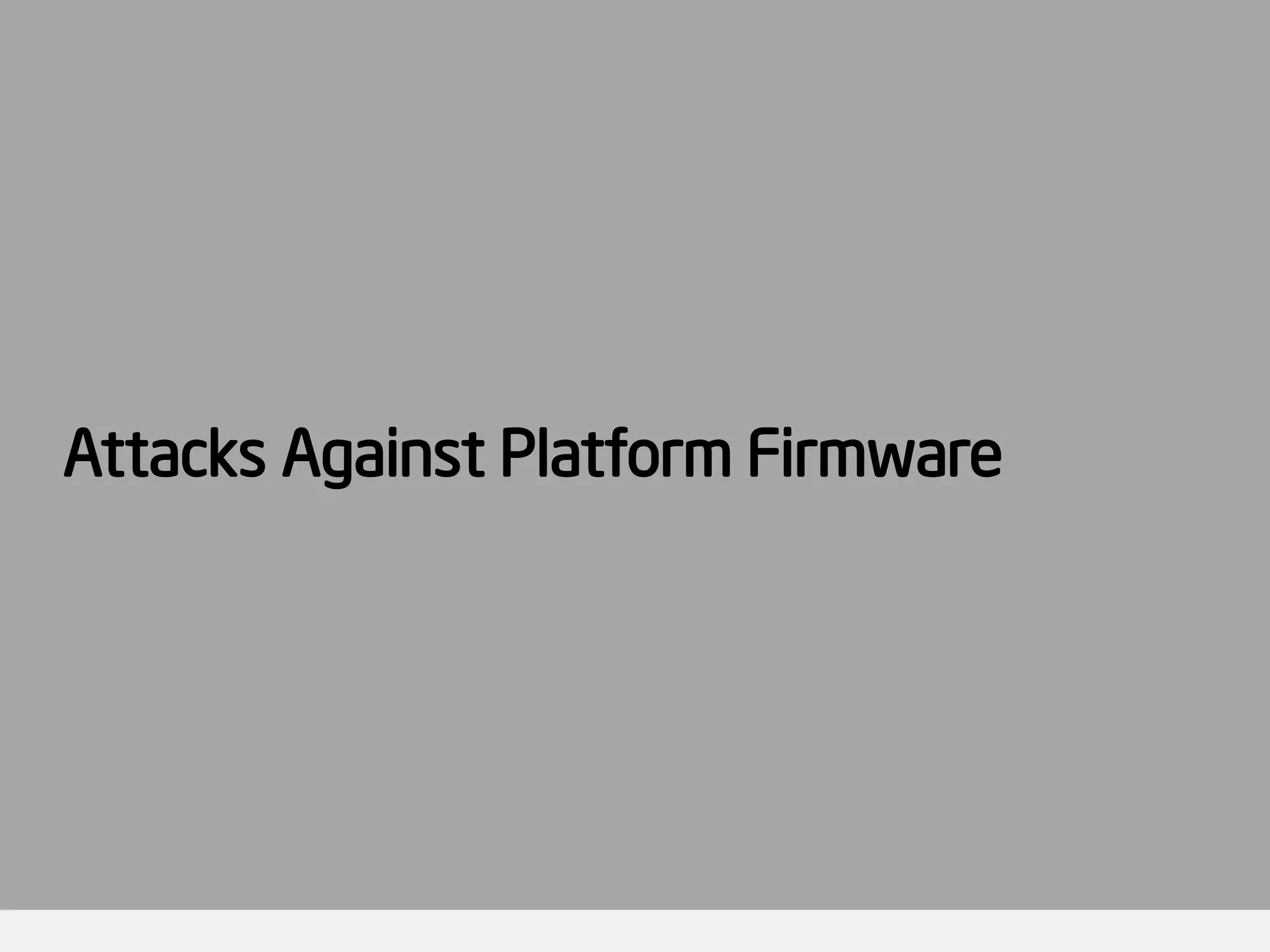


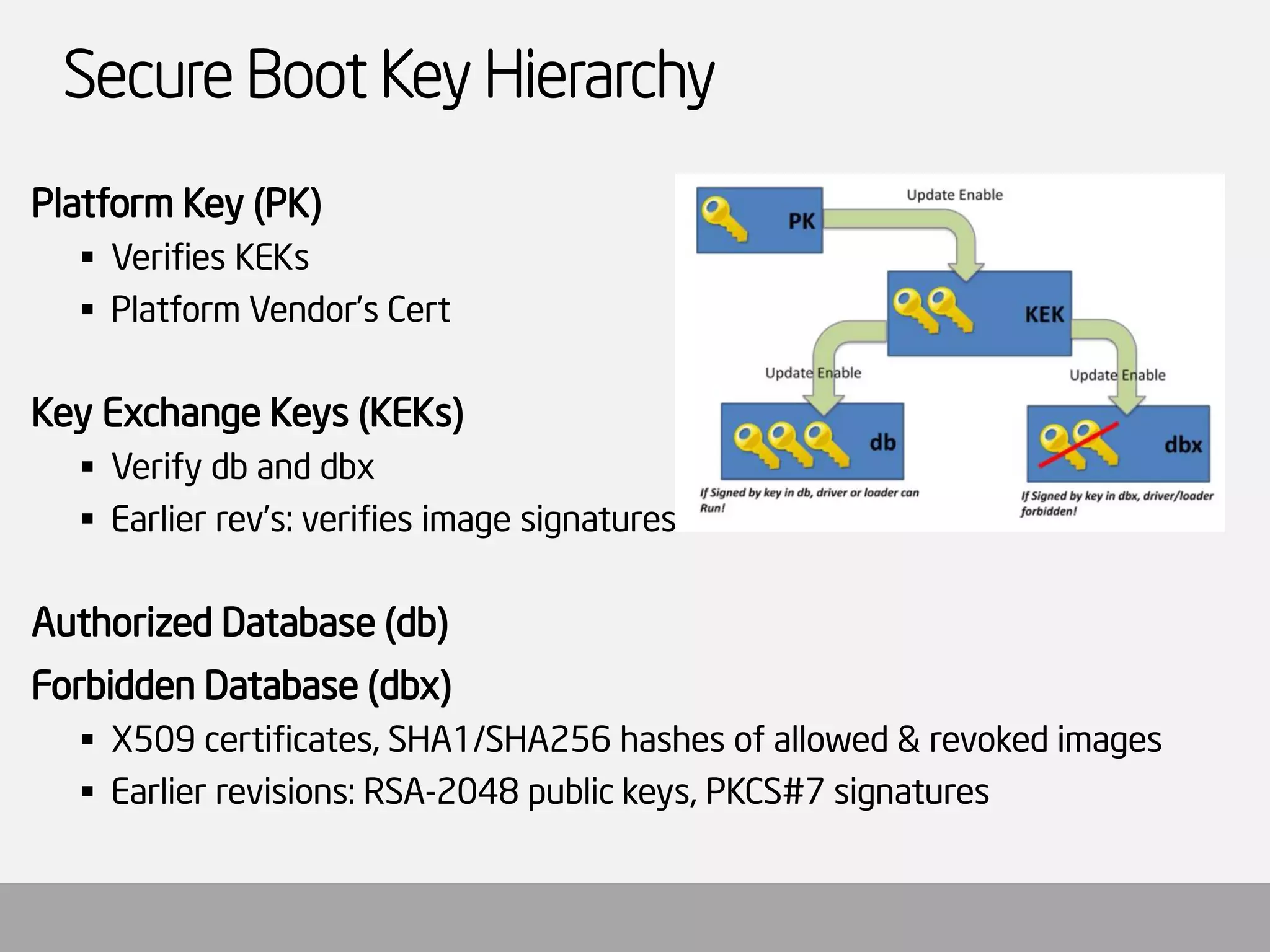
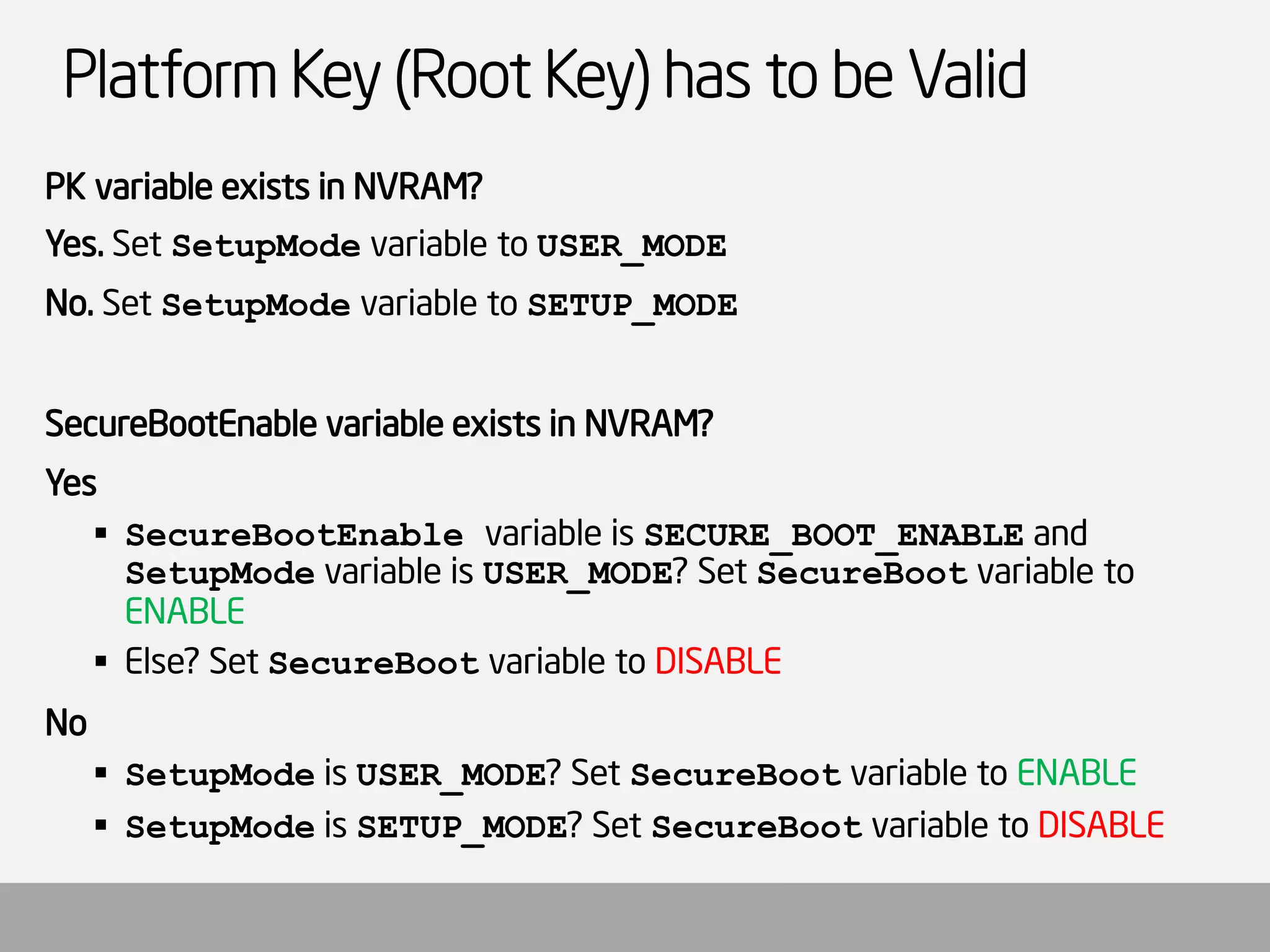
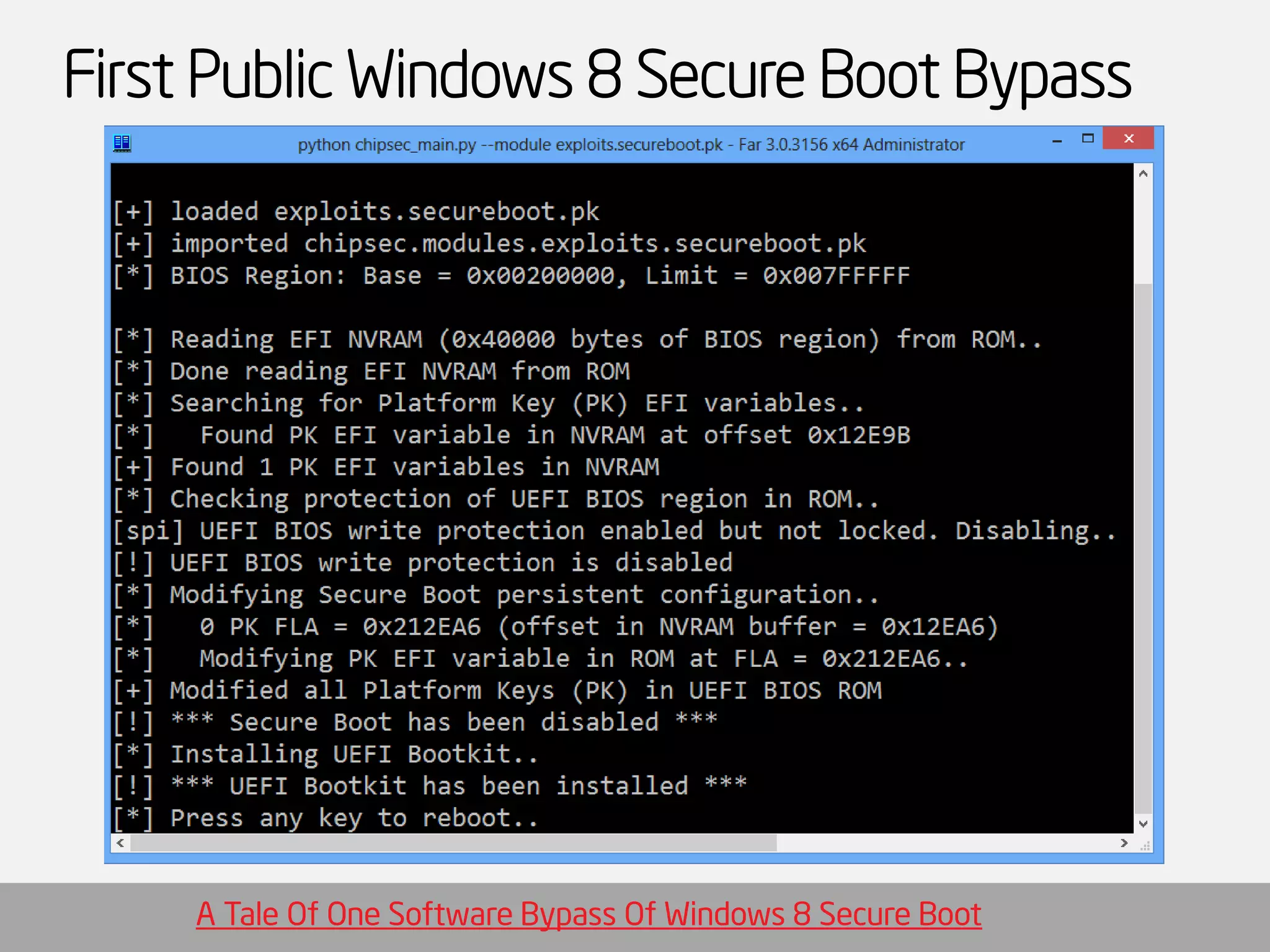
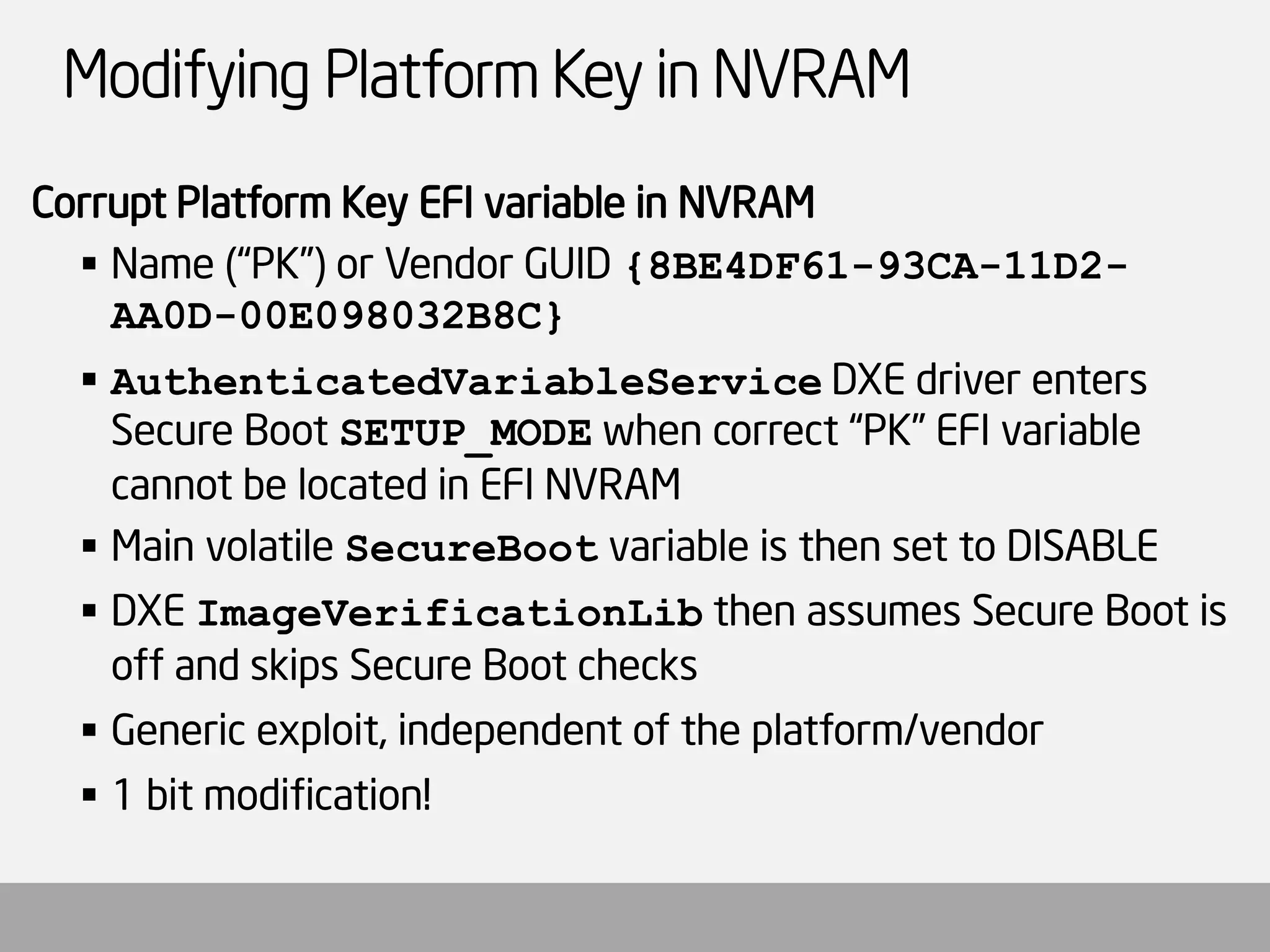
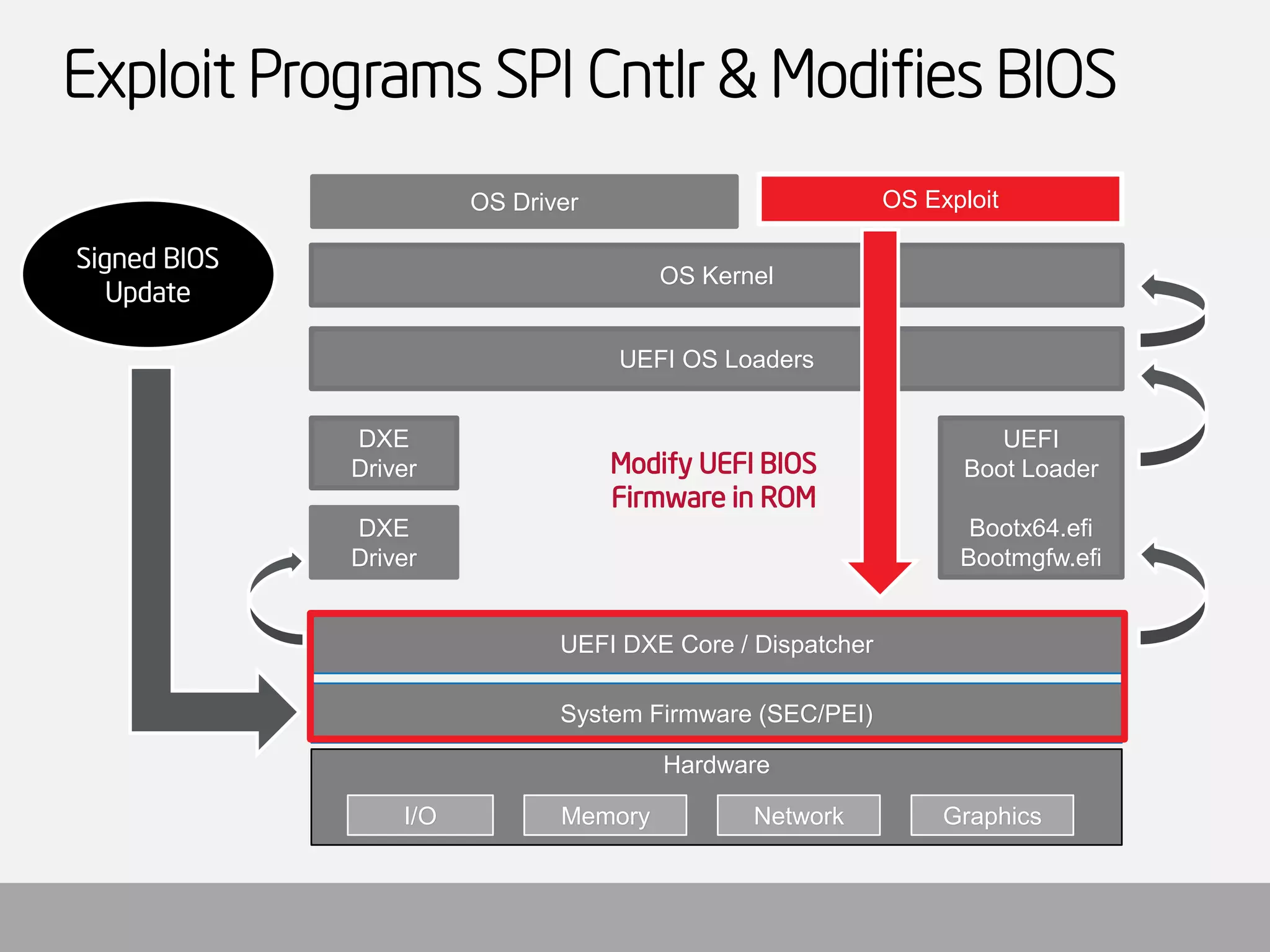

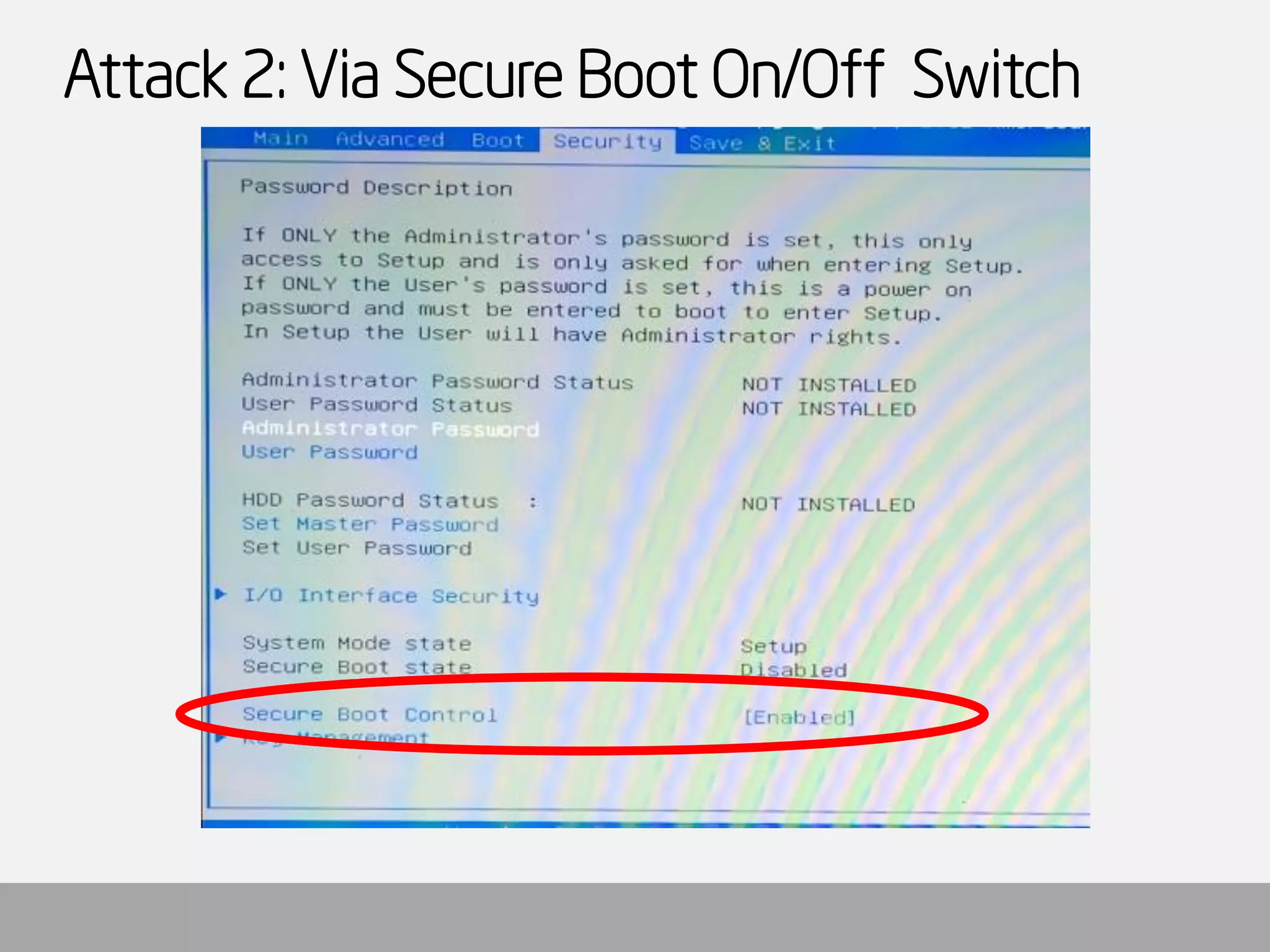
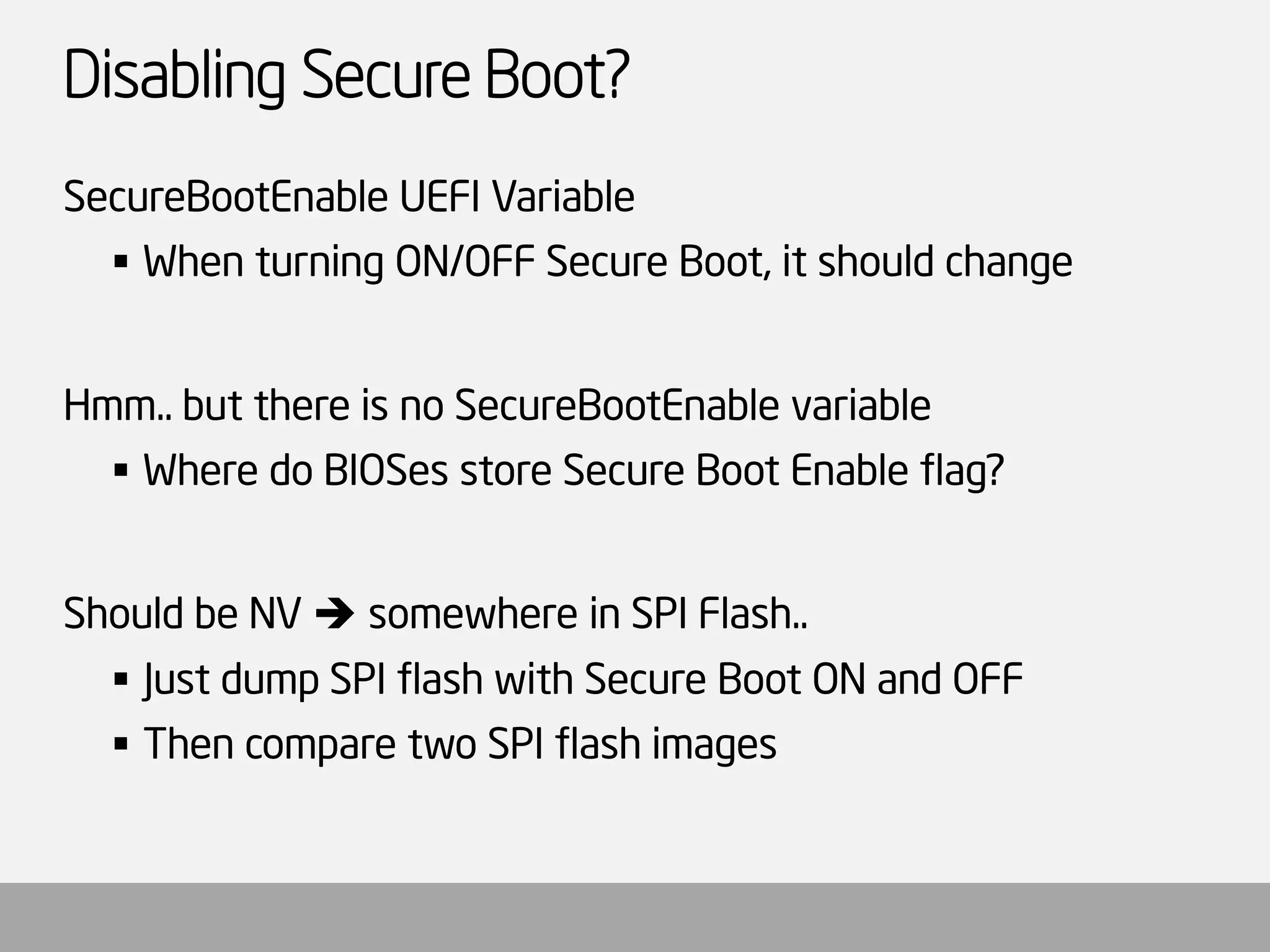

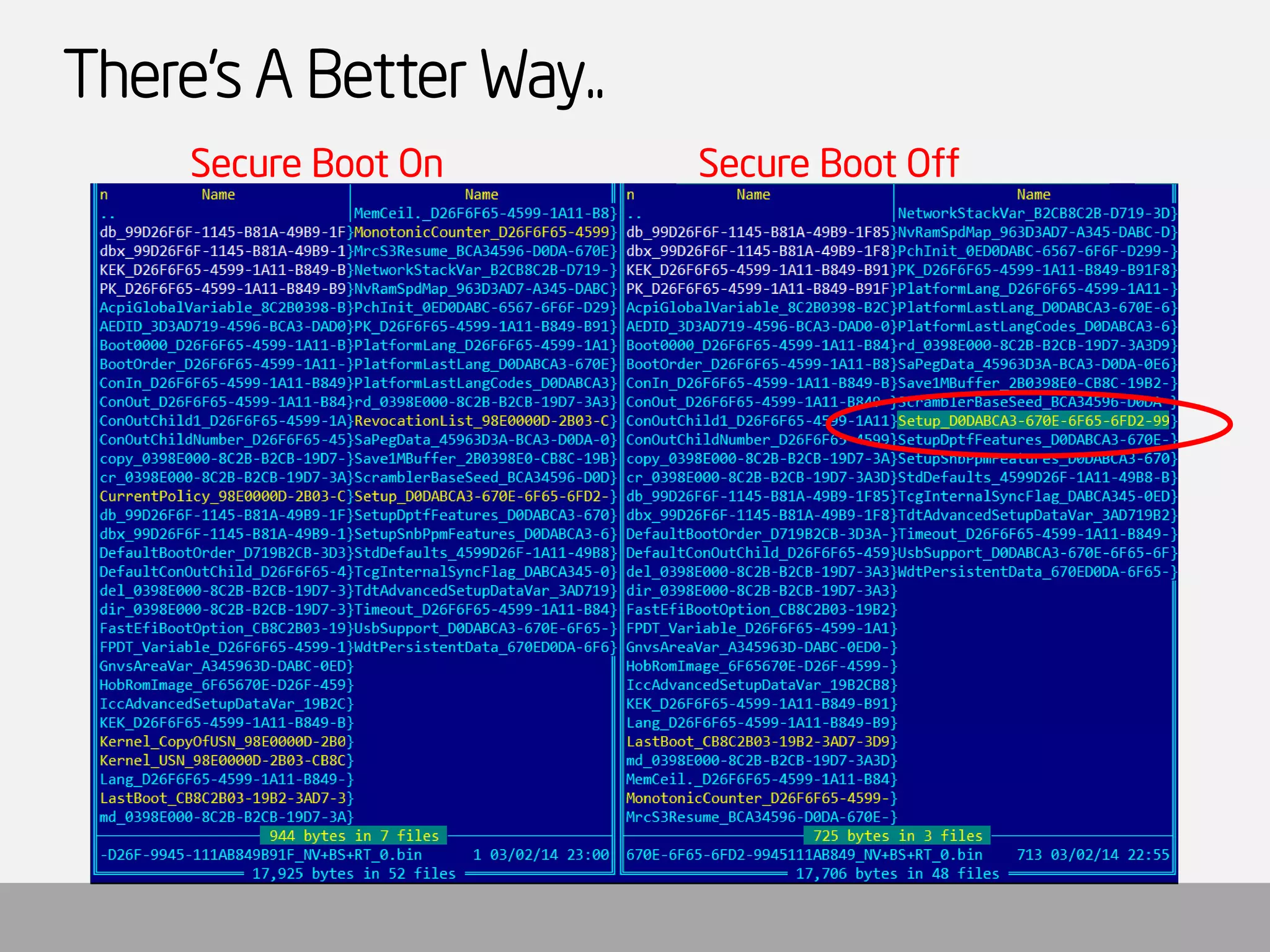
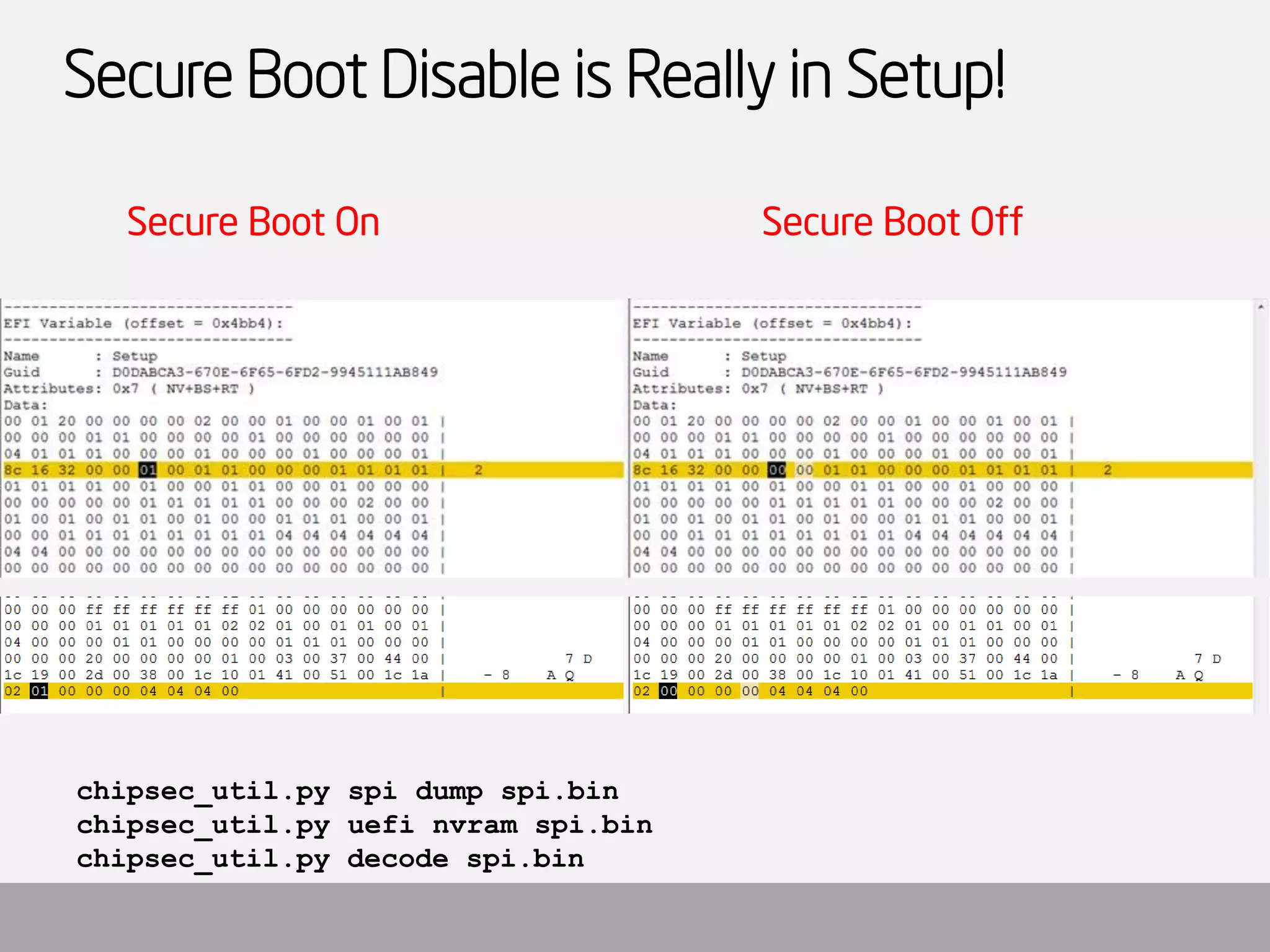
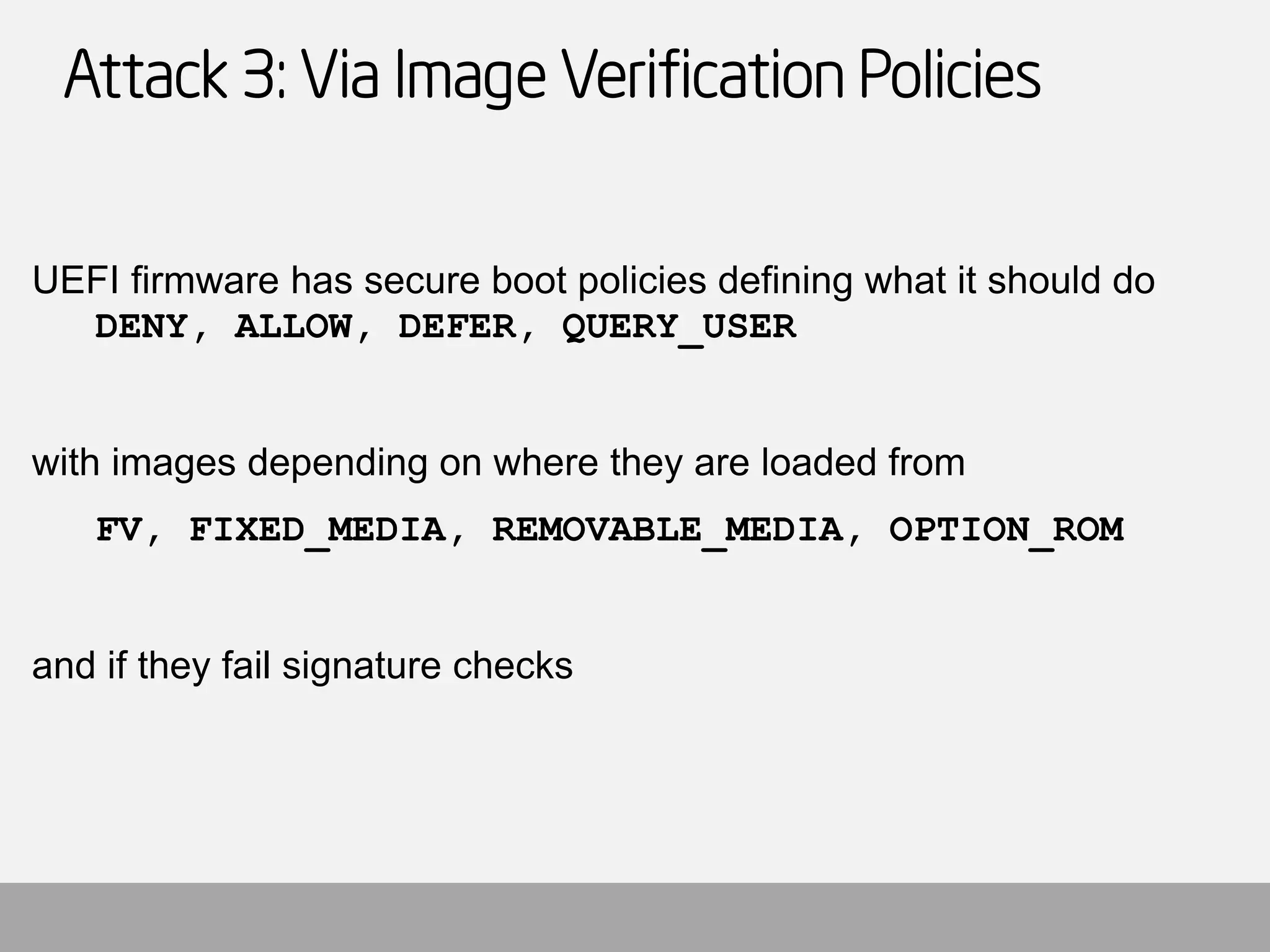
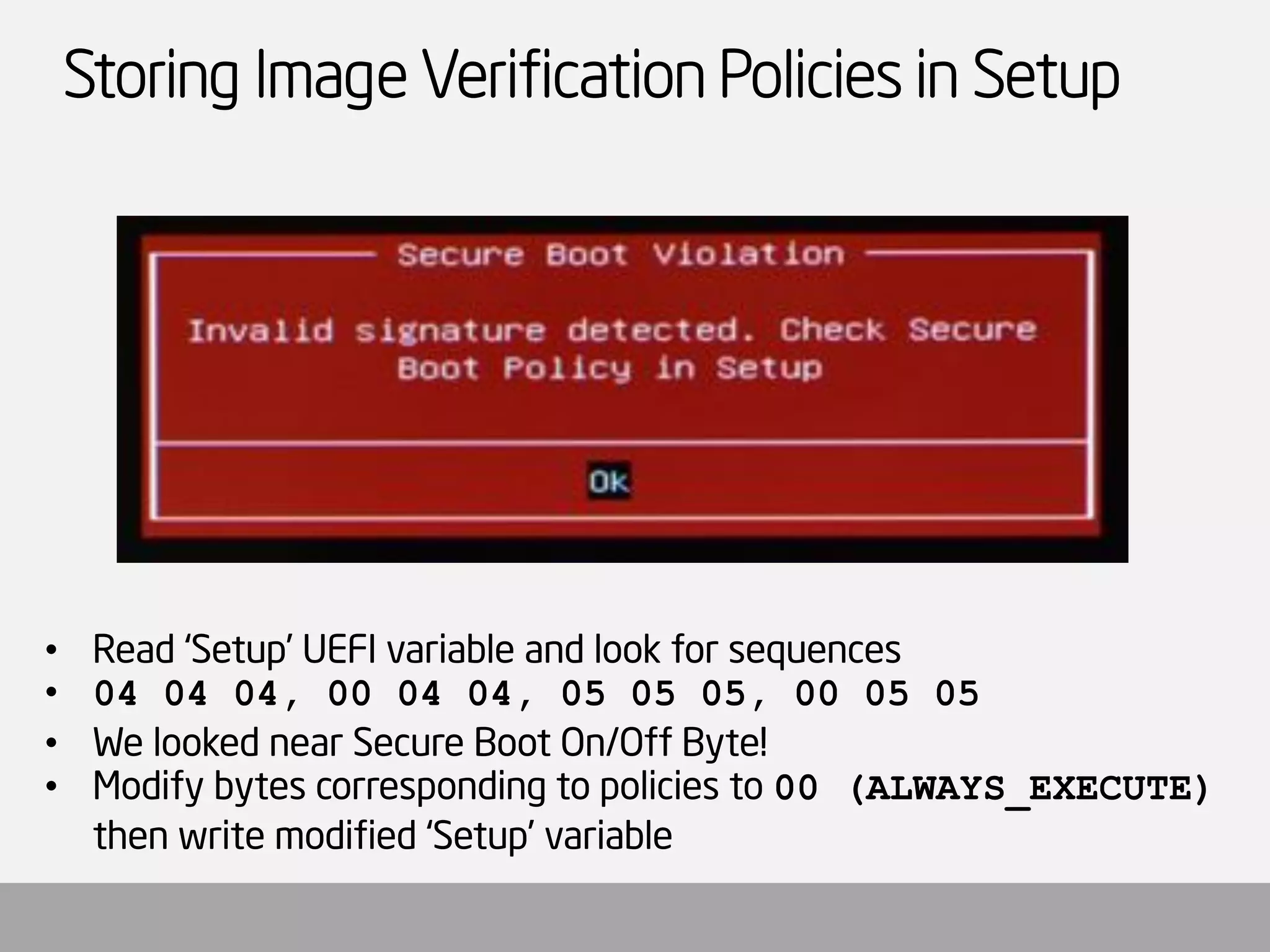
![Modifying Image Verification Policies
[CHIPSEC] Reading EFI variable Name='Setup' GUID={EC87D643-EBA4-4BB5-A1E5- 3F3E36B20DA9} from 'Setup_orig.bin' via Variable API..
EFI variable:
Name : Setup
GUID : EC87D643-EBA4-4BB5-A1E5-3F3E36B20DA9
Data :
..
01 01 01 00 00 00 00 01 01 01 00 00 00 00 00 00 |
00 00 00 00 00 00 01 01 00 00 00 04 04|
[CHIPSEC] (uefi) time elapsed 0.000
[CHIPSEC] Writing EFI variable Name='Setup' GUID={EC87D643-EBA4-4BB5-A1E5- 3F3E36B20DA9} from 'Setup_policy_exploit.bin' via Variable API..
Writing EFI variable:
Name : Setup
GUID : EC87D643-EBA4-4BB5-A1E5-3F3E36B20DA9
Data :
..
01 01 01 00 00 00 00 01 01 01 00 00 00 00 00 00 |
00 00 00 00 00 00 01 01 00 00 04 00 00|
[CHIPSEC] (uefi) time elapsed 0.203
OptionRomPolicy
FixedMediaPolicy
RemovableMediaPolicy](https://image.slidesharecdn.com/biosandsecurebootattacksuncoveredeko10-141213185452-conversion-gate01/75/BIOS-and-Secure-Boot-Attacks-Uncovered-24-2048.jpg)
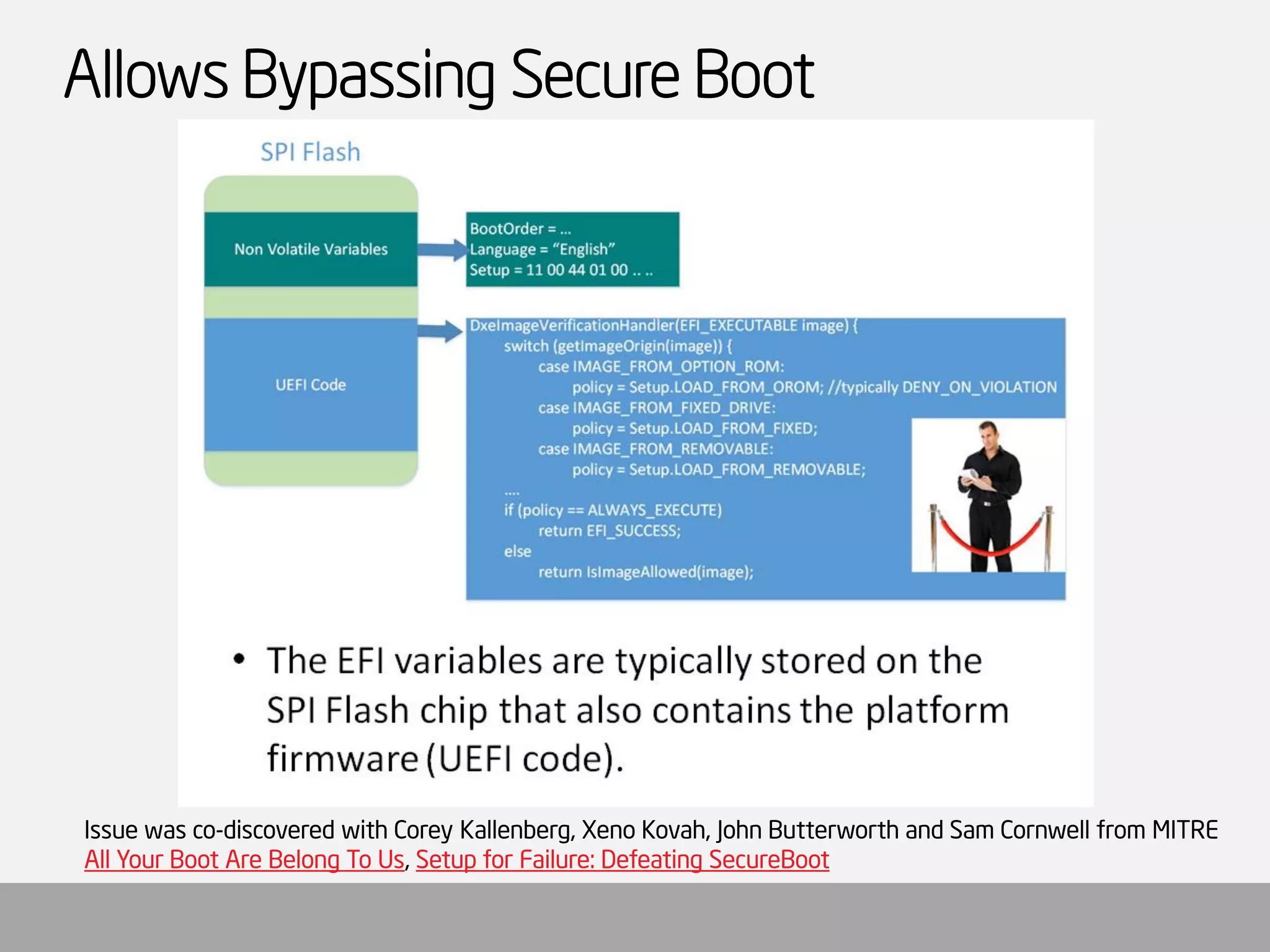
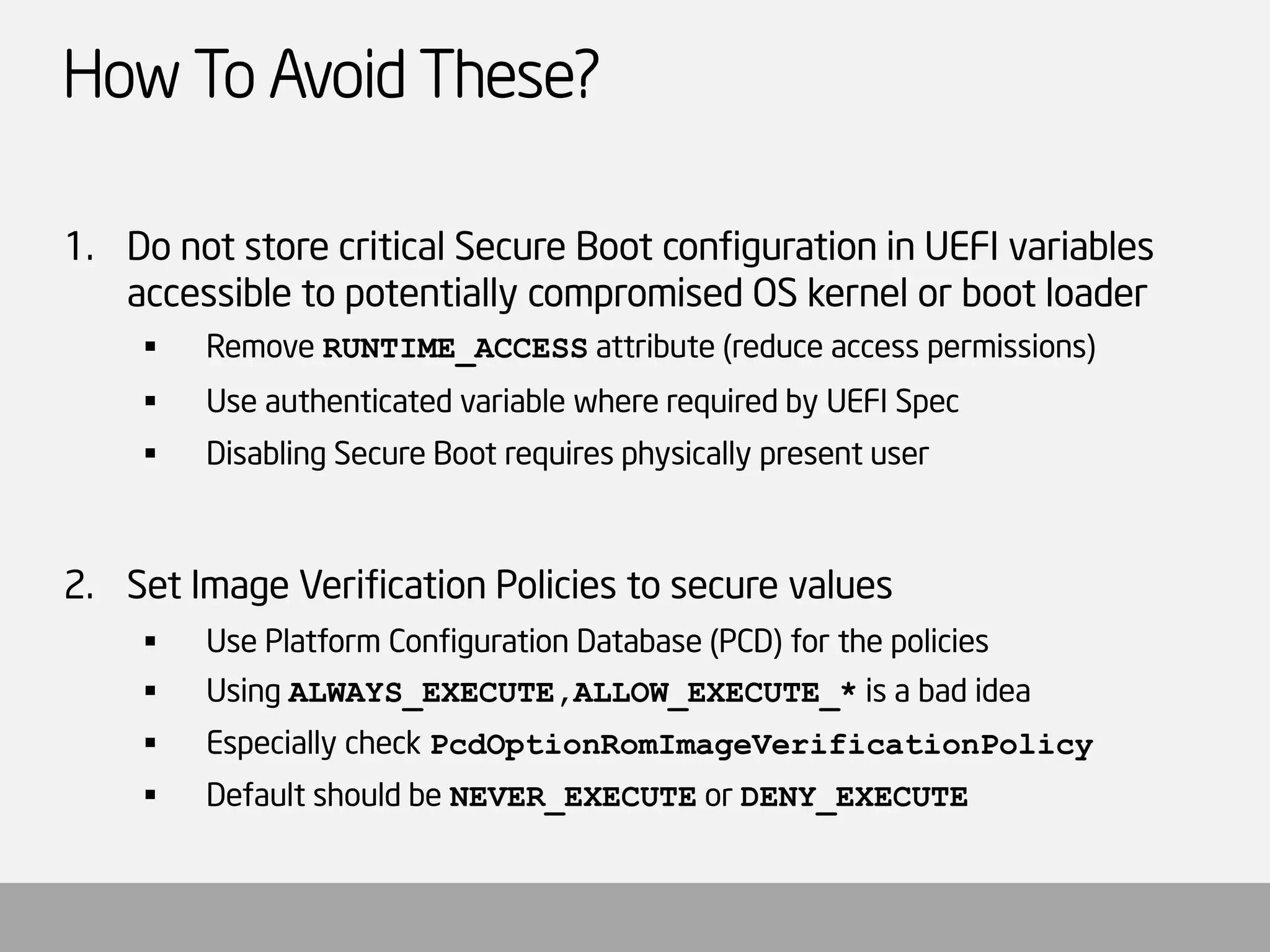
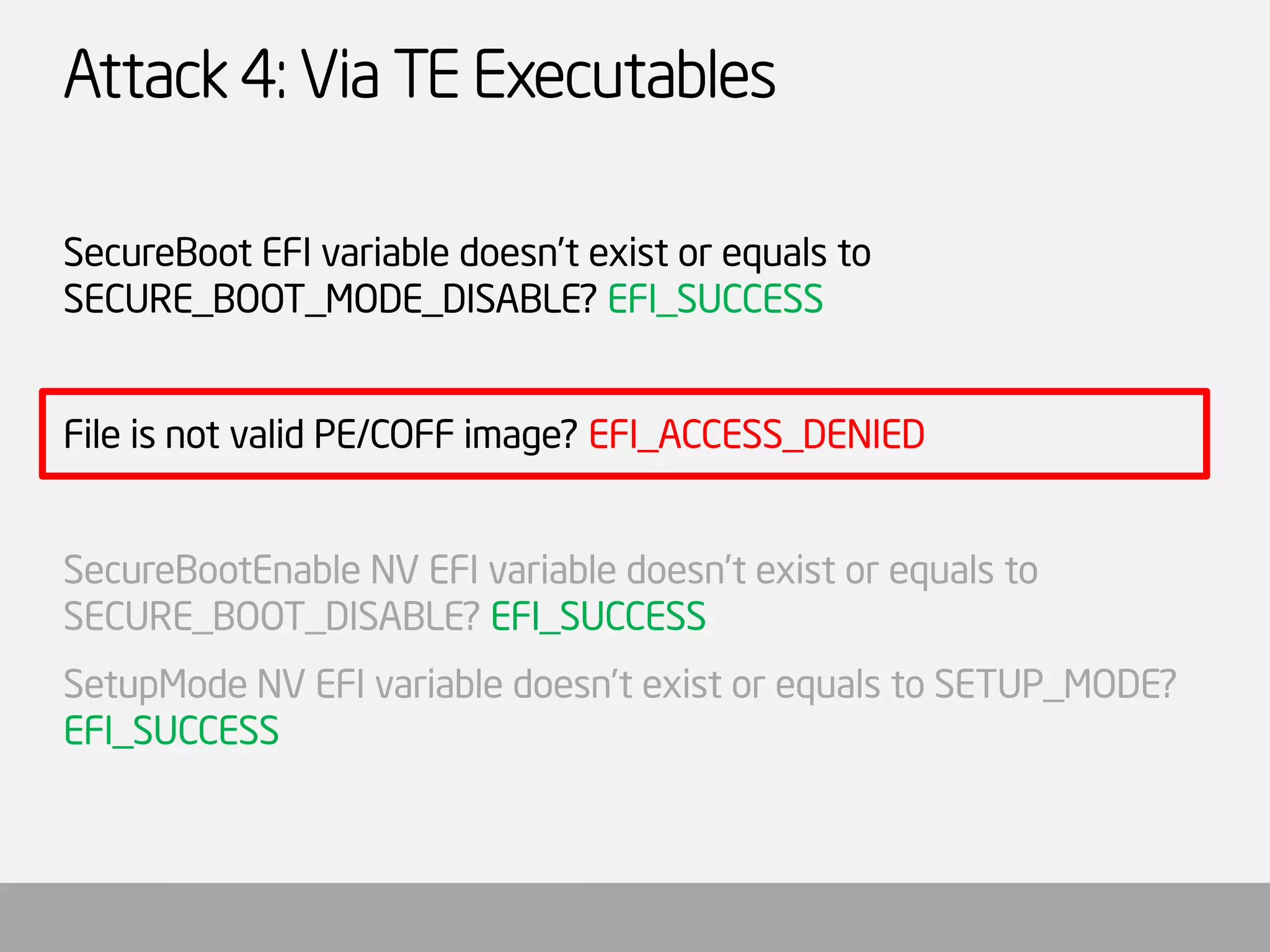
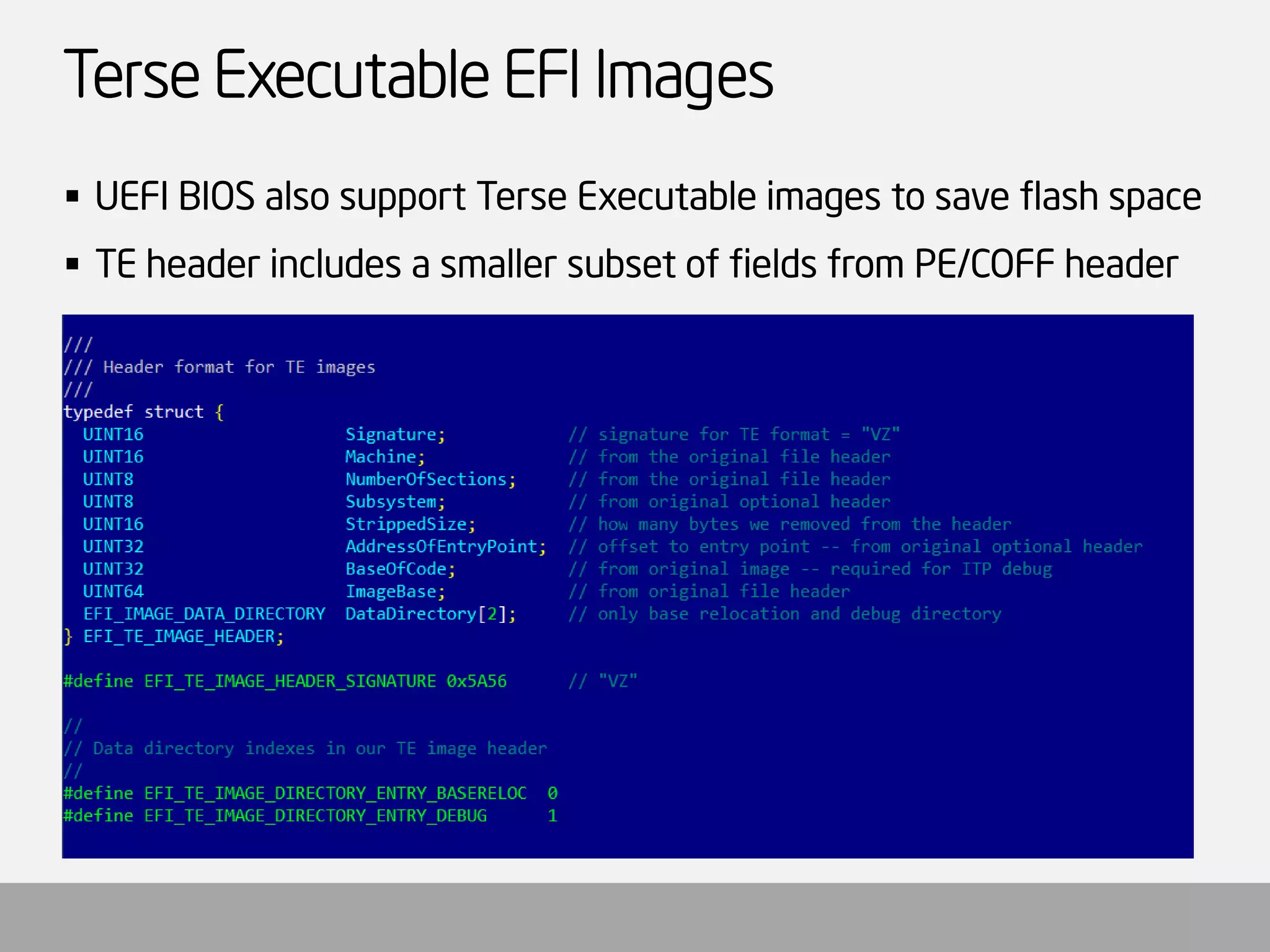

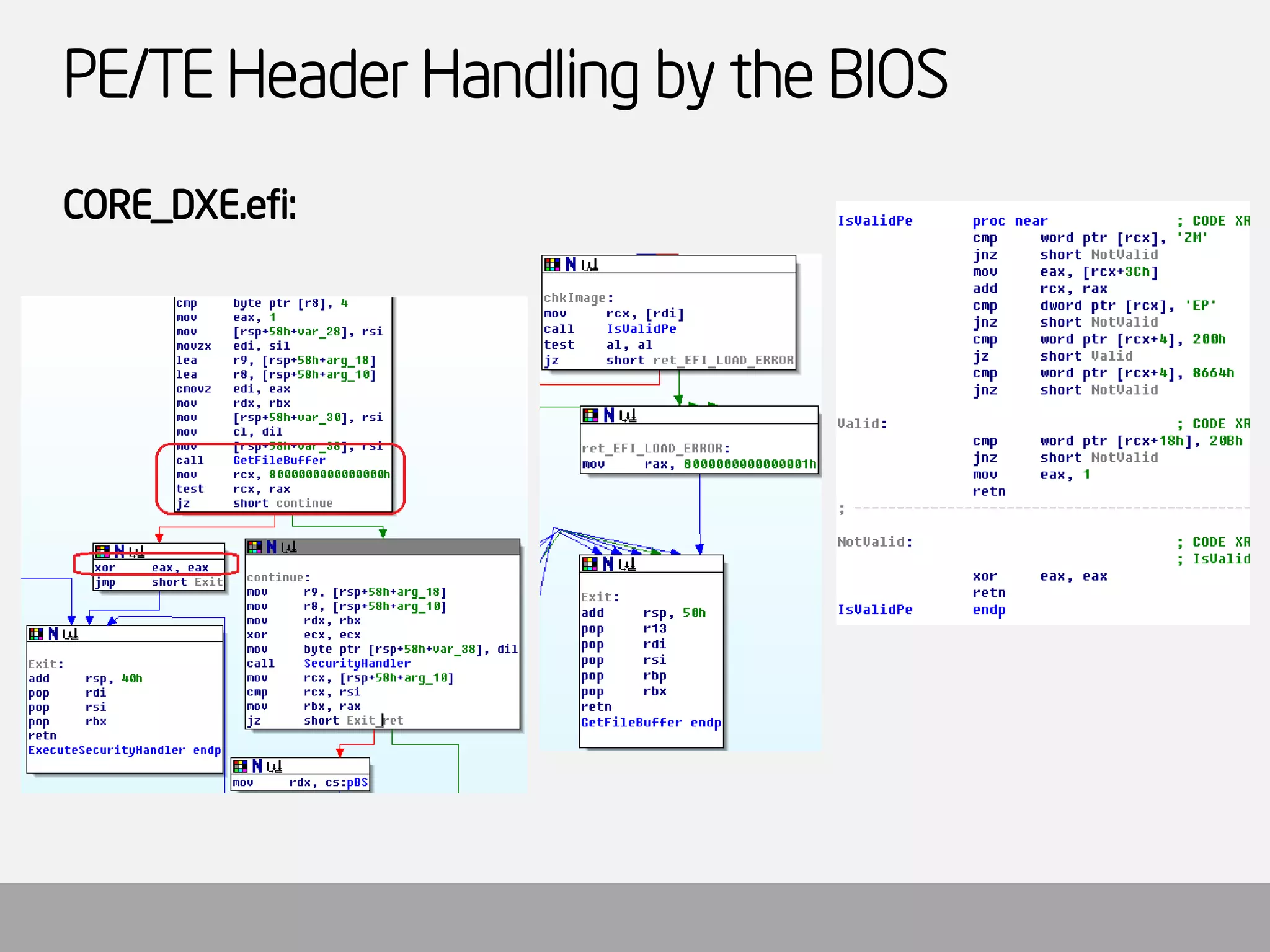

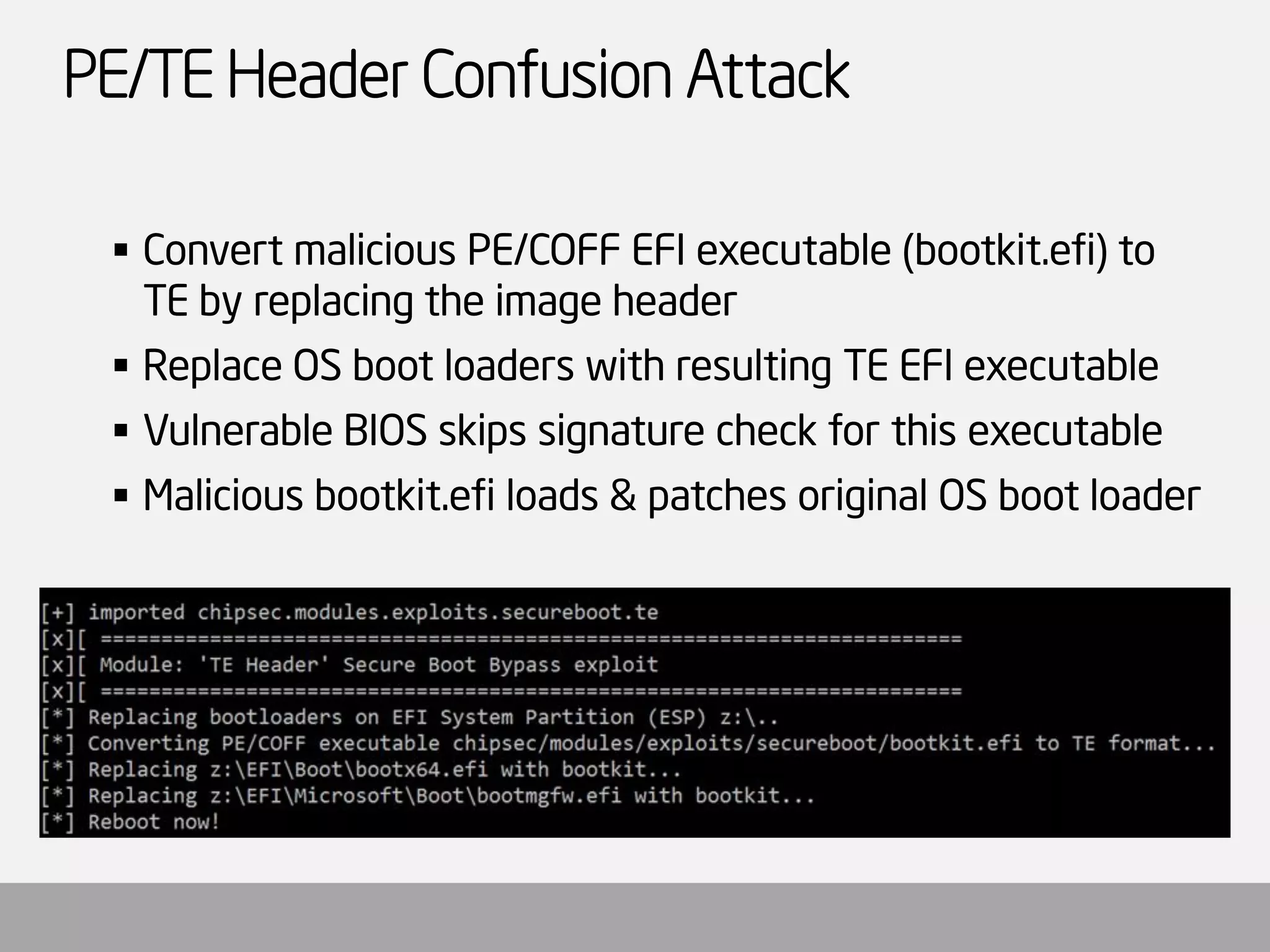
![Attack 5: Via Compatibility Support Module
•CSM allows legacy boot on top of UEFI firmware
•Legacy boot: [Unsigned] MBR, Option ROMs, etc.
•We found that some systems have CSM enabled by default with Secure Boot and fallback to boot from MBR when UEFI signature check fails
•Other systems don’t allow CSM=ON in BIOS Setup opts
•While storing CSM Enable policy in Setup UEFI variable
CSM and Secure Boot](https://image.slidesharecdn.com/biosandsecurebootattacksuncoveredeko10-141213185452-conversion-gate01/75/BIOS-and-Secure-Boot-Attacks-Uncovered-33-2048.jpg)
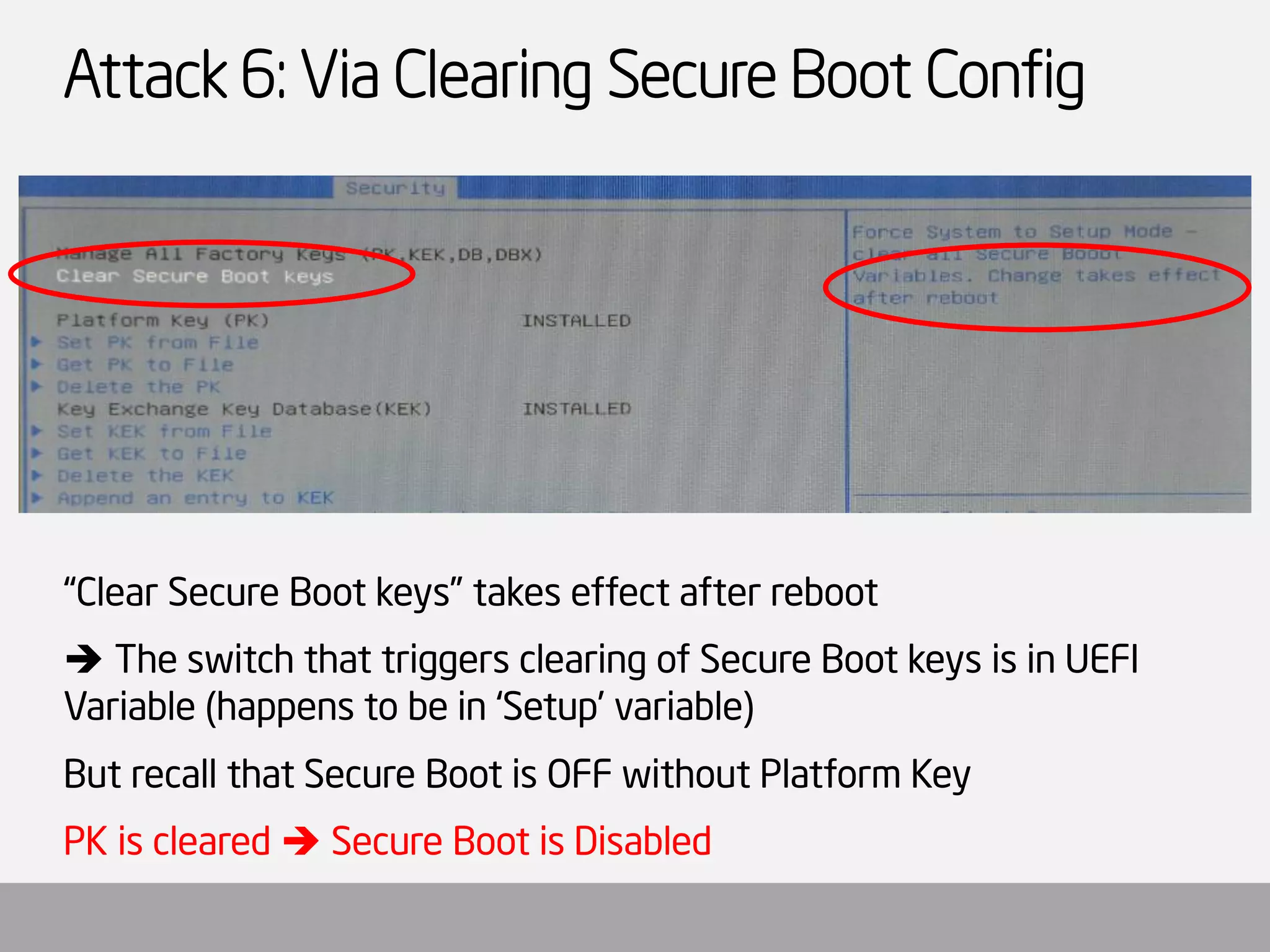
![Attack 7: Via Restoring Default Config
Default Secure Boot keys can be restored [When there’s no PK]
Switch that triggers restore of Secure Boot keys to their default values is in UEFI Variable (happens to be in ‘Setup’)
Nah.. Default keys are protected. They are in FV
But we just added 9 hashesto the DBX blacklist ](https://image.slidesharecdn.com/biosandsecurebootattacksuncoveredeko10-141213185452-conversion-gate01/75/BIOS-and-Secure-Boot-Attacks-Uncovered-35-2048.jpg)
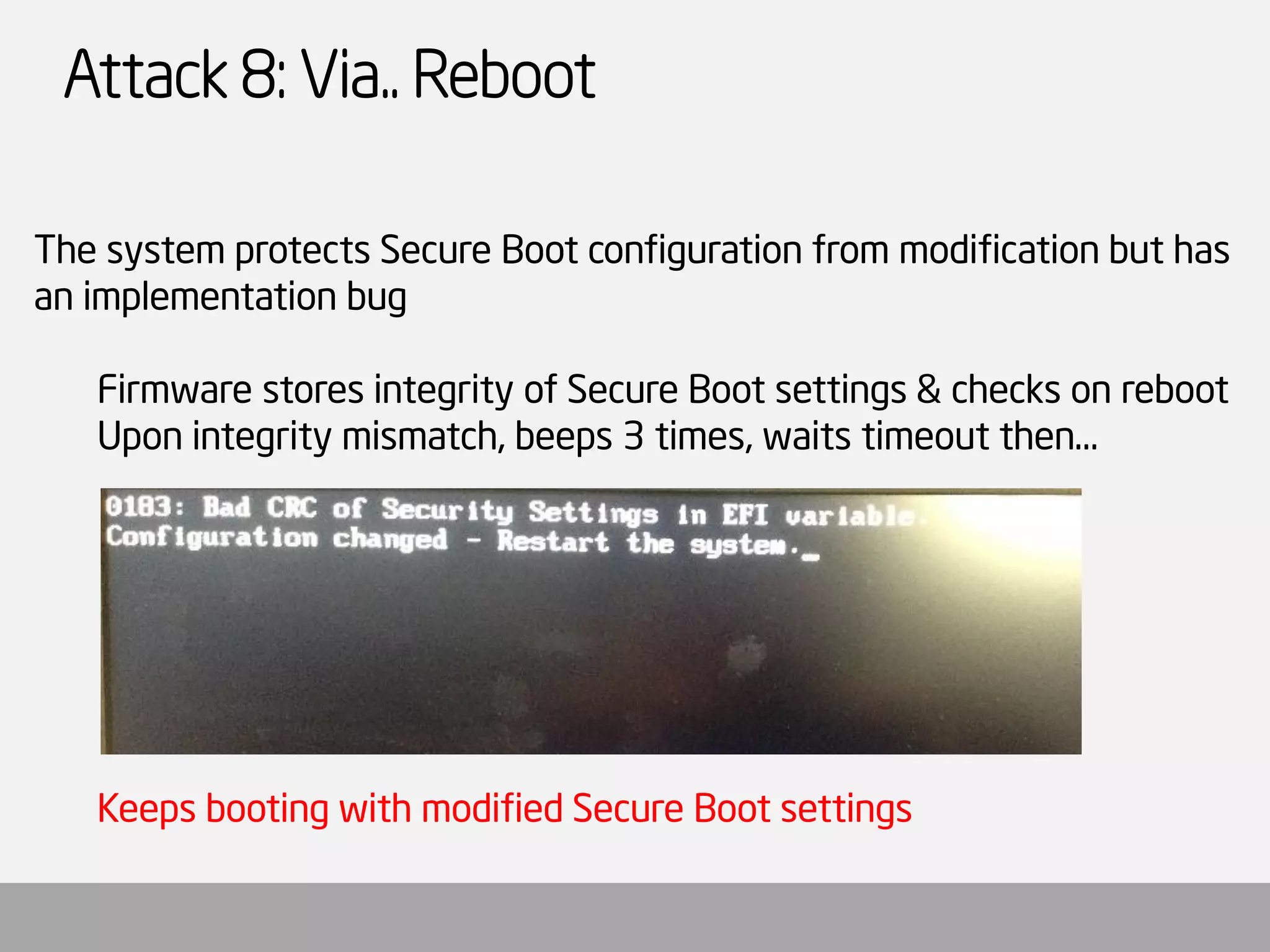

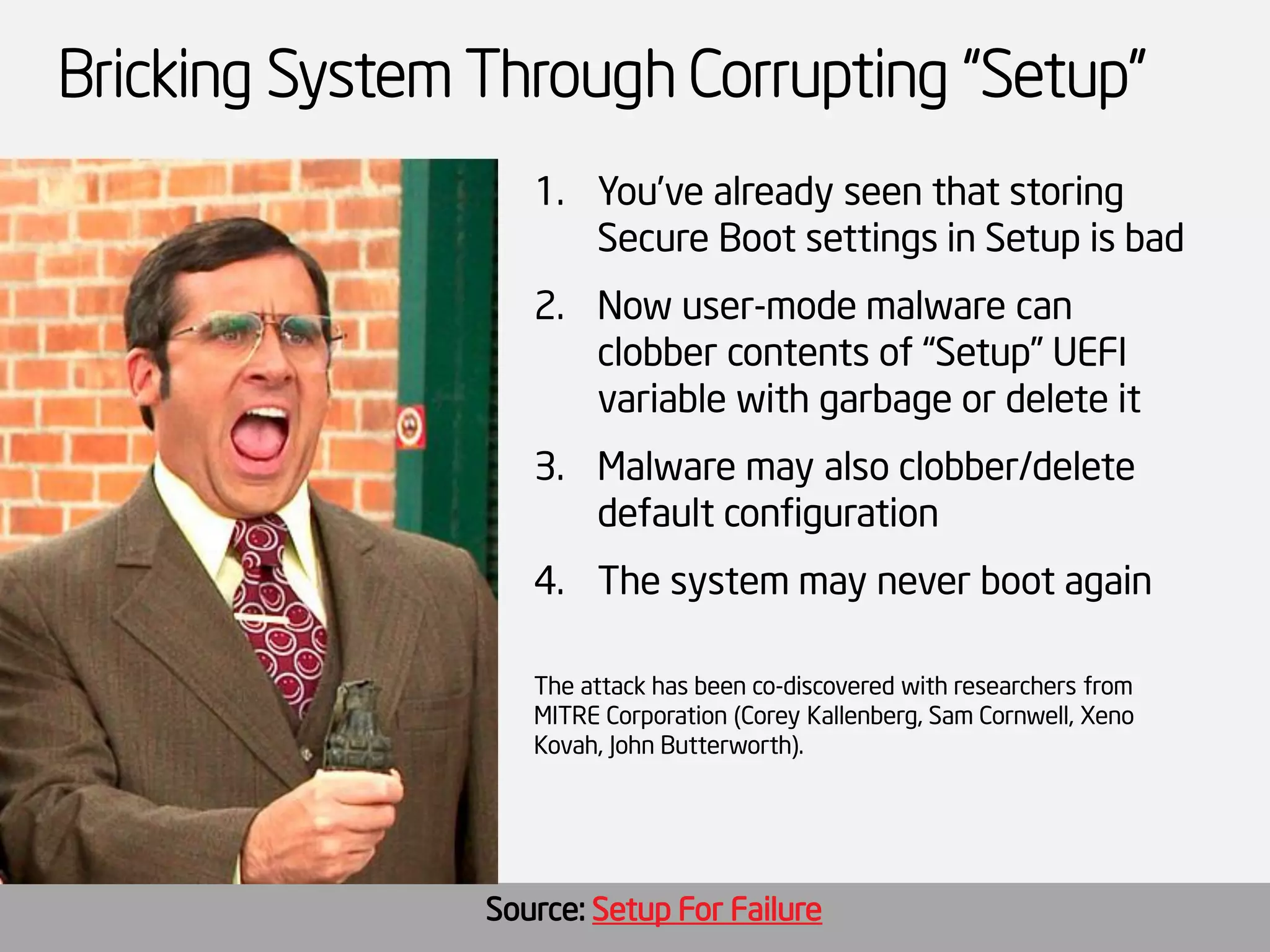
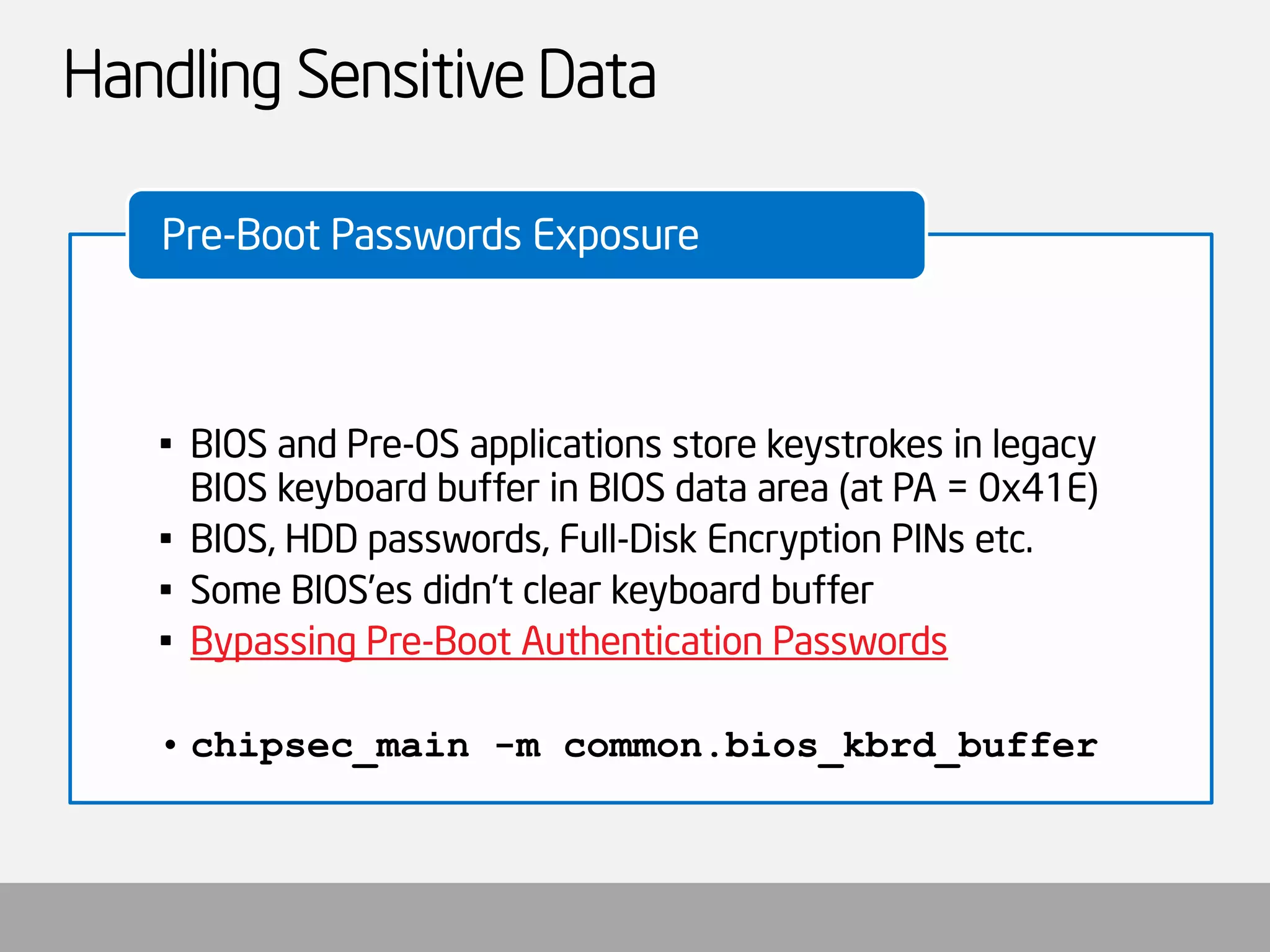

![BIOS Write Protection in SPI Flash Memory
•Often still not properly enabled on many systems
•SMM based write protection of entire BIOS region is often not used: BIOS_CONTROL[SMM_BWP]
•If SPI Protected Ranges (mode agnostic) are used (defined by PR0- PR4 in SPI MMIO), they often don’t cover entire BIOS & NVRAM
•Some platforms use SPI device specific WP protection but only for boot block/startup code or SPI Flash descriptor region
•Persistent BIOS Infection(used coreboot’sflashromon legacy BIOS)
•Evil Maid Just Got Angrier: Why FDE with TPM is Not Secure on Many Systems
•BIOS Chronomancy: Fixing the Static Root of Trust for Measurement
•A Tale Of One Software Bypass Of Windows 8 Secure Boot
•Mitigation: BIOS_CONTROL[SMM_BWP] = 1 and SPI PRx
•chipsec_main--module common.bios_wp
•Or Copernicusfrom MITRE
SPI Flash (BIOS) Write Protection is Still a Problem](https://image.slidesharecdn.com/biosandsecurebootattacksuncoveredeko10-141213185452-conversion-gate01/75/BIOS-and-Secure-Boot-Attacks-Uncovered-41-2048.jpg)

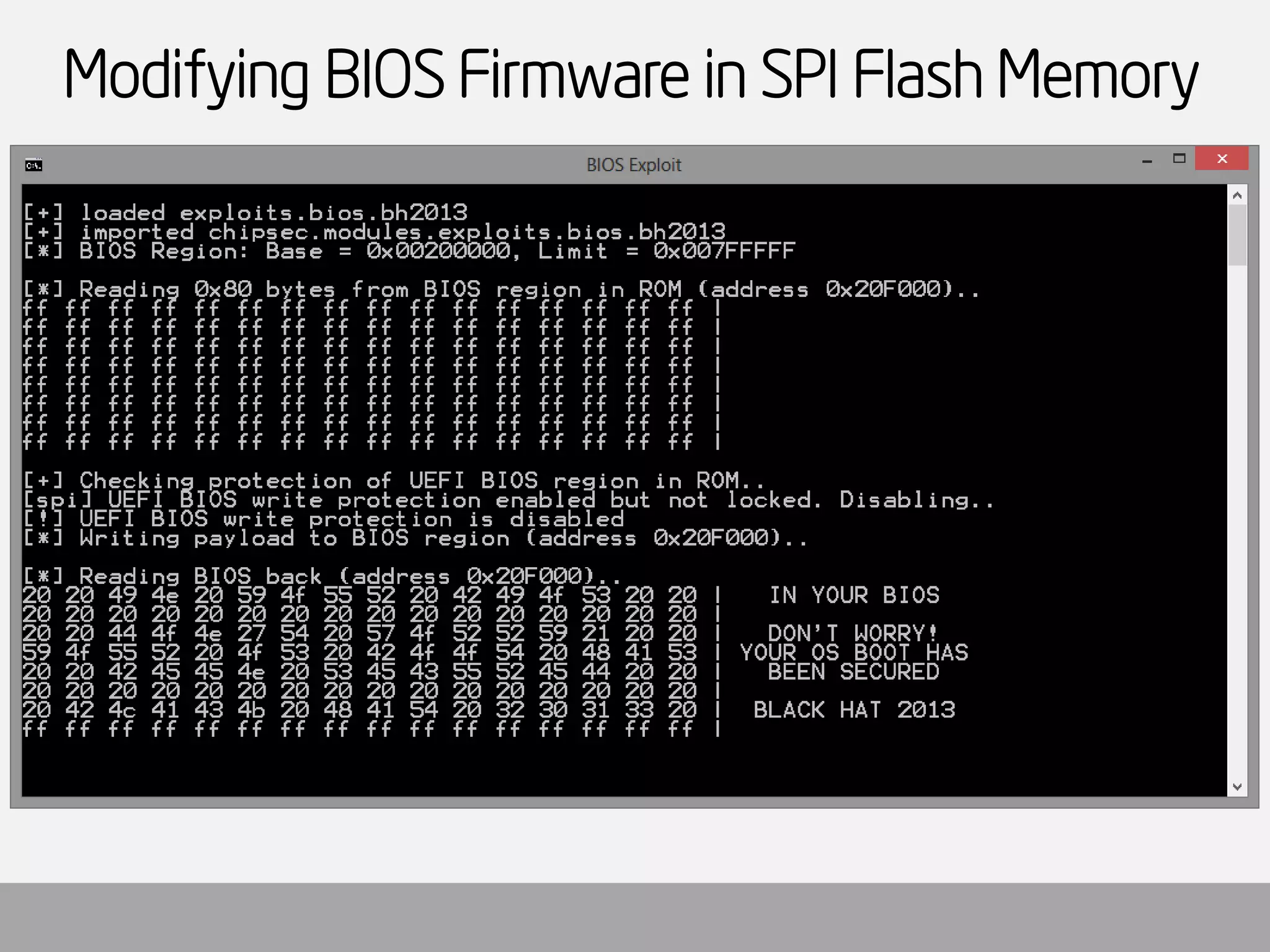
![From Analytics, and Scalability, and UEFI Exploitationby Teddy Reed
Patch attempts to enable BIOS write protection (sets BIOS_CONTROL[BLE]). Picked up by Subzero](https://image.slidesharecdn.com/biosandsecurebootattacksuncoveredeko10-141213185452-conversion-gate01/75/BIOS-and-Secure-Boot-Attacks-Uncovered-44-2048.jpg)
![SPI Flash Write Protection
•Some systems write-protect BIOS by disabling BIOS Write-Enable (BIOSWE) and setting BIOS Lock Enable (BLE) but don’t use SMM based write-protection BIOS_CONTROL[SMM_BWP]
•SMI event is generated when Update SW writes BIOSWE=1
•Possible attack against this configuration is to block SMI events
•E.g. disable all chipset sources of SMI: clear SMI_EN[GBL_SMI_EN] if BIOS didn’t lock SMI config: Setup for Failure: Defeating SecureBoot
•Another variantis to disable specific TCO SMIsource used for BIOSWE/BLE (clear SMI_EN[TCO_EN] if BIOS didn’t lock TCO config.)
•Mitigation: BIOS_CONTROL[SMM_BWP] = 1 and lock SMI config
•chipsec_main--module common.bios_smi
SMI Suppression Attack Variants](https://image.slidesharecdn.com/biosandsecurebootattacksuncoveredeko10-141213185452-conversion-gate01/75/BIOS-and-Secure-Boot-Attacks-Uncovered-45-2048.jpg)


![Problems With HW Configuration/Protections
•D_LCK bit locks down Compatible SMM space (a.k.a. CSEG) configuration (SMRAMC)
•SMRAMC[D_OPEN]=0 forces access to legacy SMM space decode to system bus rather than to DRAM where SMI handlers are when CPU is not in System Management Mode (SMM)
•When D_LCK is not set by BIOS, SMM space decode can be changed to open access to CSEG when CPU is not in SMM: Using CPU SMM to Circumvent OS Security Functions
•Also Using SMM For Other Purposes
•chipsec_main–-module common.smm
Unlocked Compatible/Legacy SMRAM](https://image.slidesharecdn.com/biosandsecurebootattacksuncoveredeko10-141213185452-conversion-gate01/75/BIOS-and-Secure-Boot-Attacks-Uncovered-48-2048.jpg)
![Compatible SMM Space: Normal Decode
0xBFFFF
Compatible SMRAM (CSEG)
SMM access to CSEG is decoded to DRAM, non-SMM access is sent to system bus
0xA0000
Non SMM access
SMRAMC [D_LCK] = 1
SMRAMC [D_OPEN] = 0
Source: Using CPU SMM to Circumvent OS Security Functions, Using SMM For Other Purposes](https://image.slidesharecdn.com/biosandsecurebootattacksuncoveredeko10-141213185452-conversion-gate01/75/BIOS-and-Secure-Boot-Attacks-Uncovered-49-2048.jpg)
![Compatible SMM Space: Unlocked
0xBFFFF
Compatible SMRAM (CSEG)
Non-SMM access to CSEG is decoded to DRAM where SMI handlers can be modified
0xA0000
Non SMM access
SMRAMC [D_LCK] = 0
SMRAMC [D_OPEN] = 1
Source: Using CPU SMM to Circumvent OS Security Functions, Using SMM For Other Purposes](https://image.slidesharecdn.com/biosandsecurebootattacksuncoveredeko10-141213185452-conversion-gate01/75/BIOS-and-Secure-Boot-Attacks-Uncovered-50-2048.jpg)
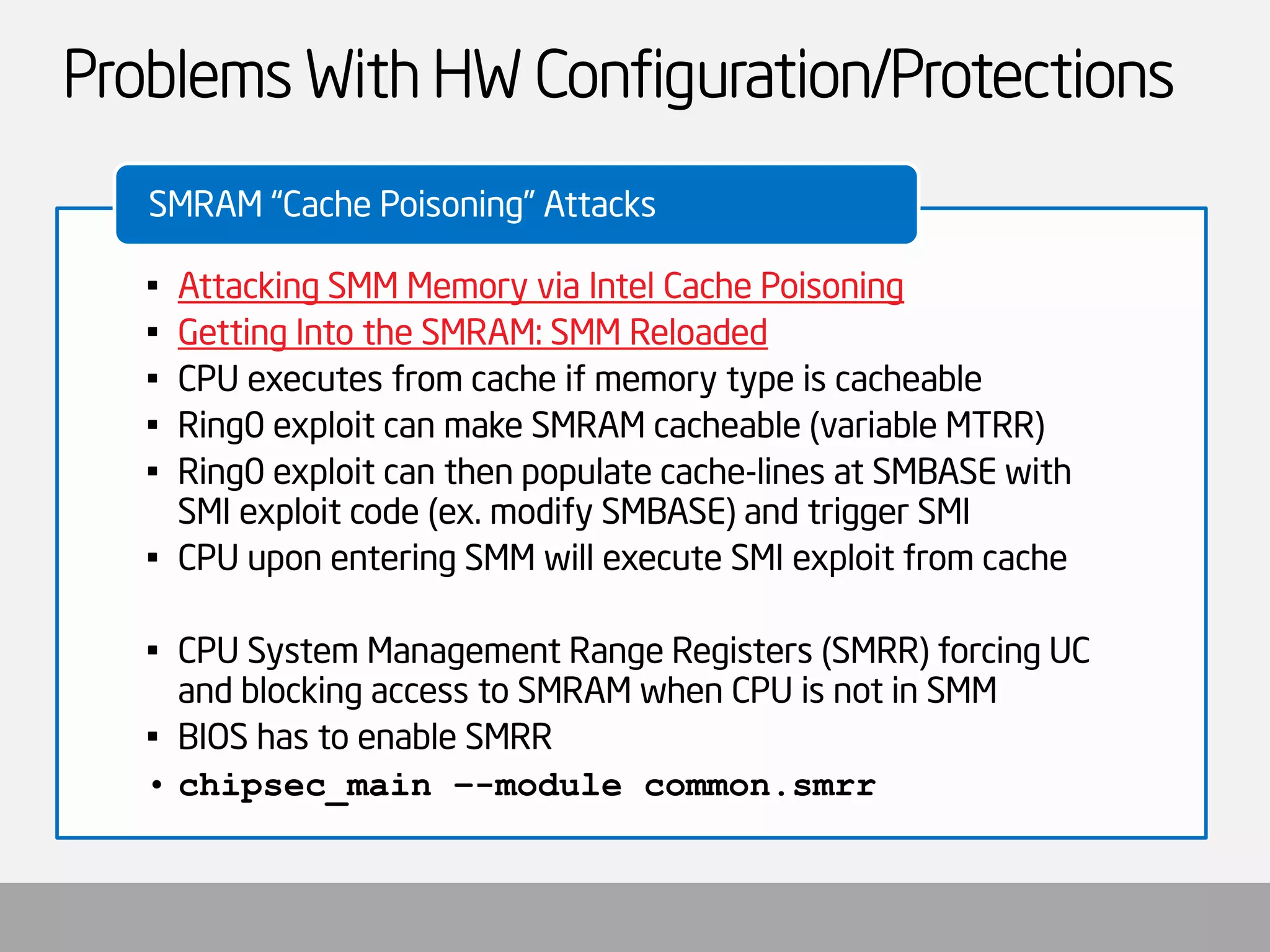
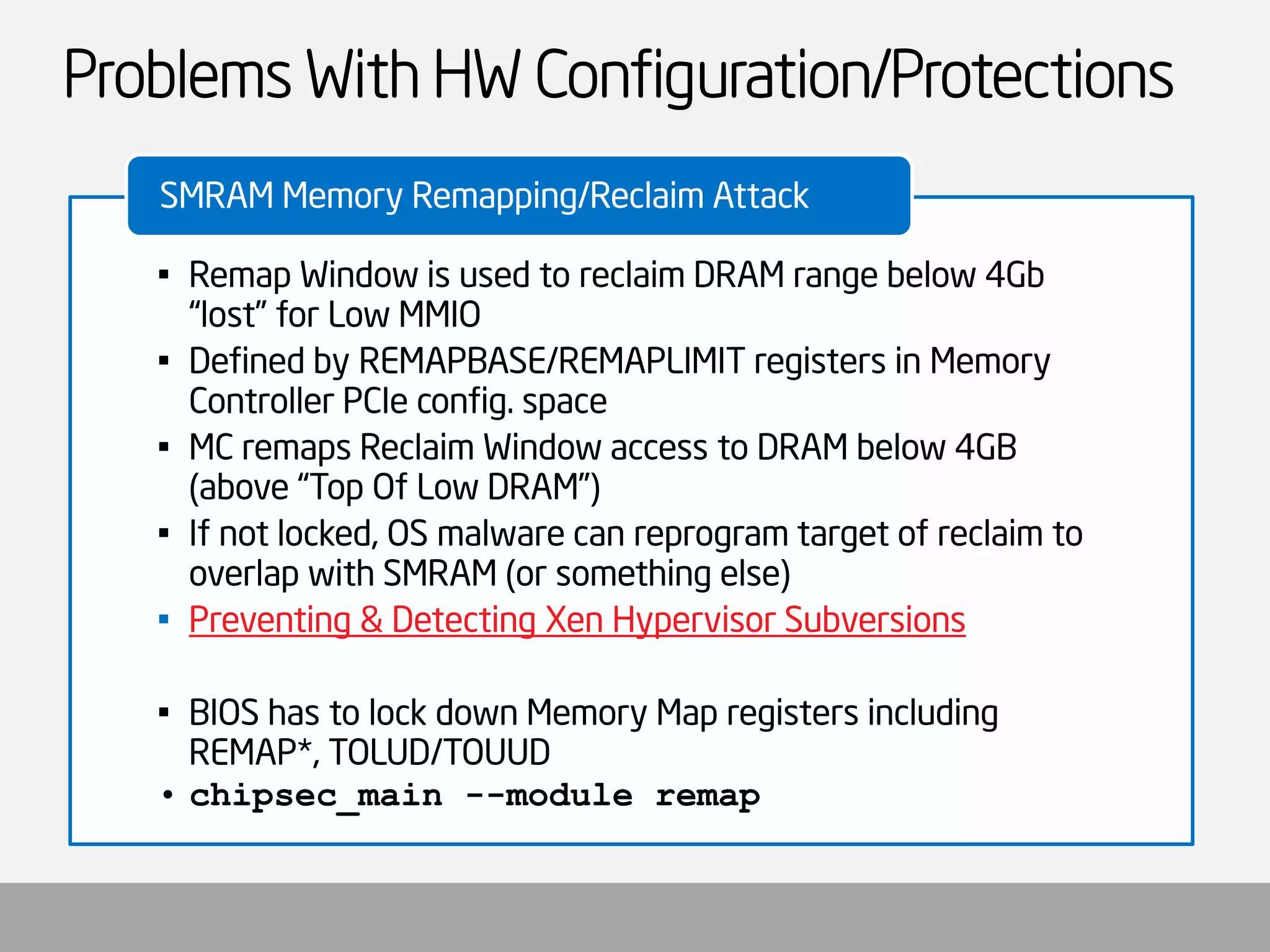
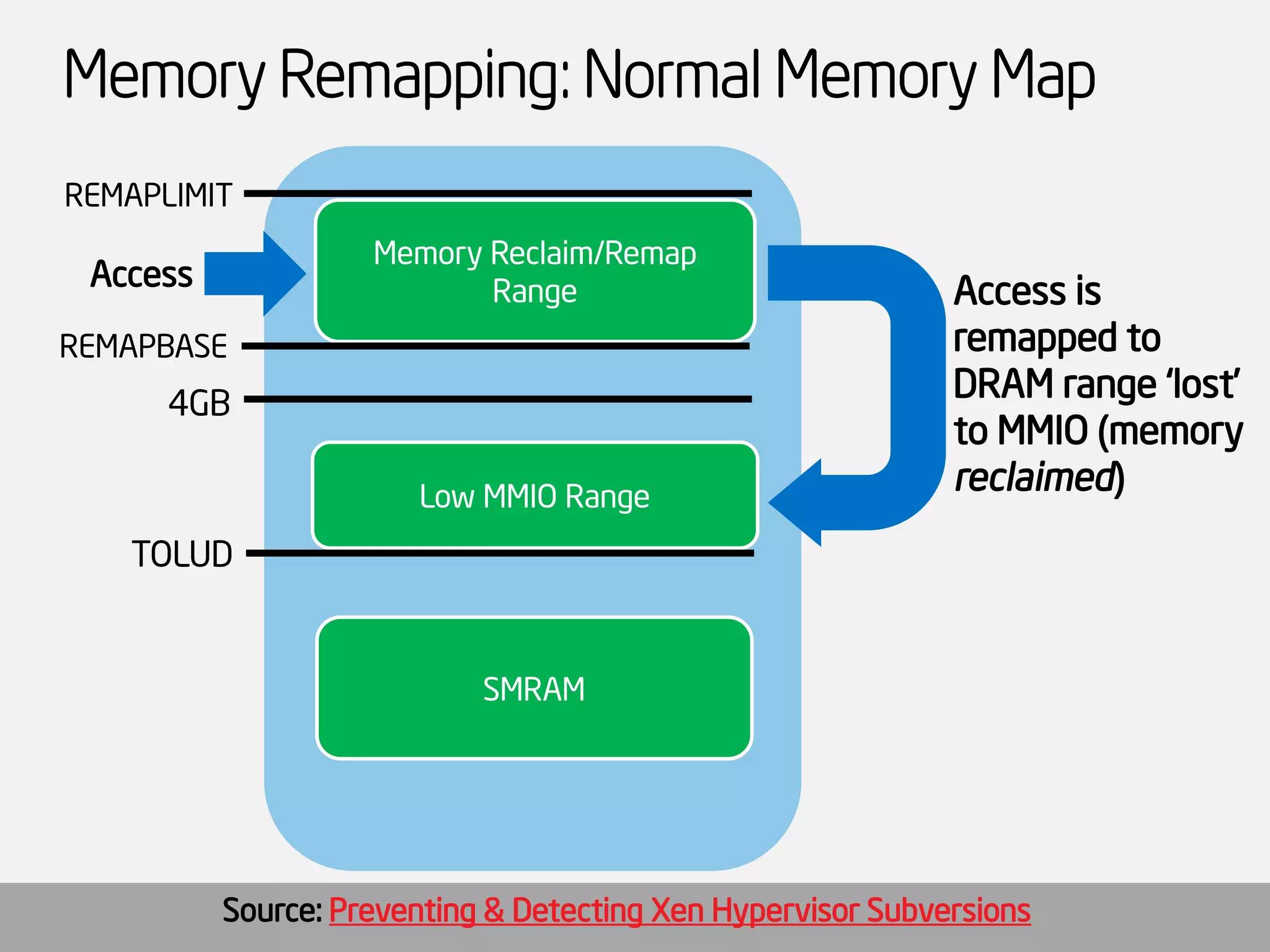
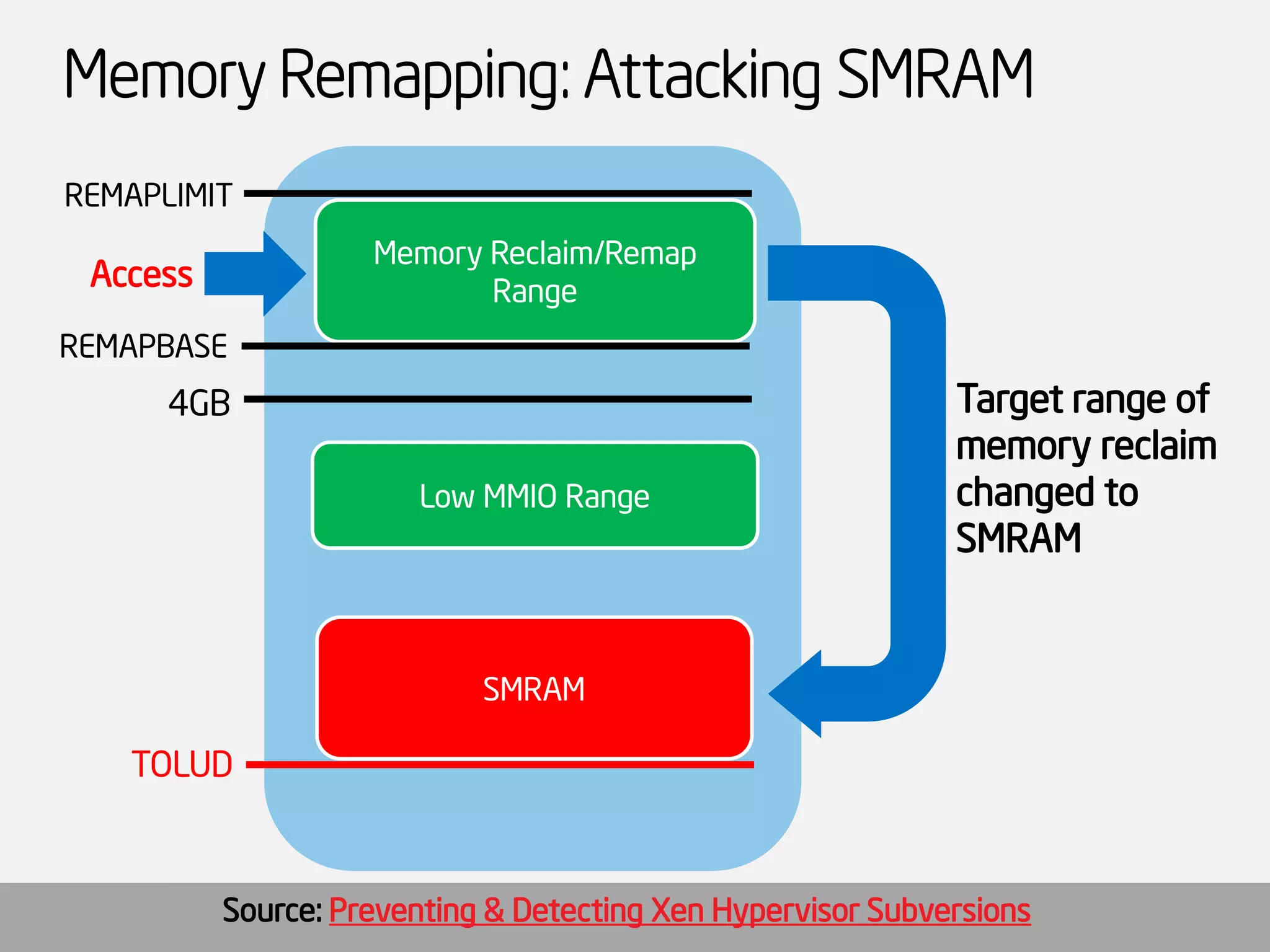
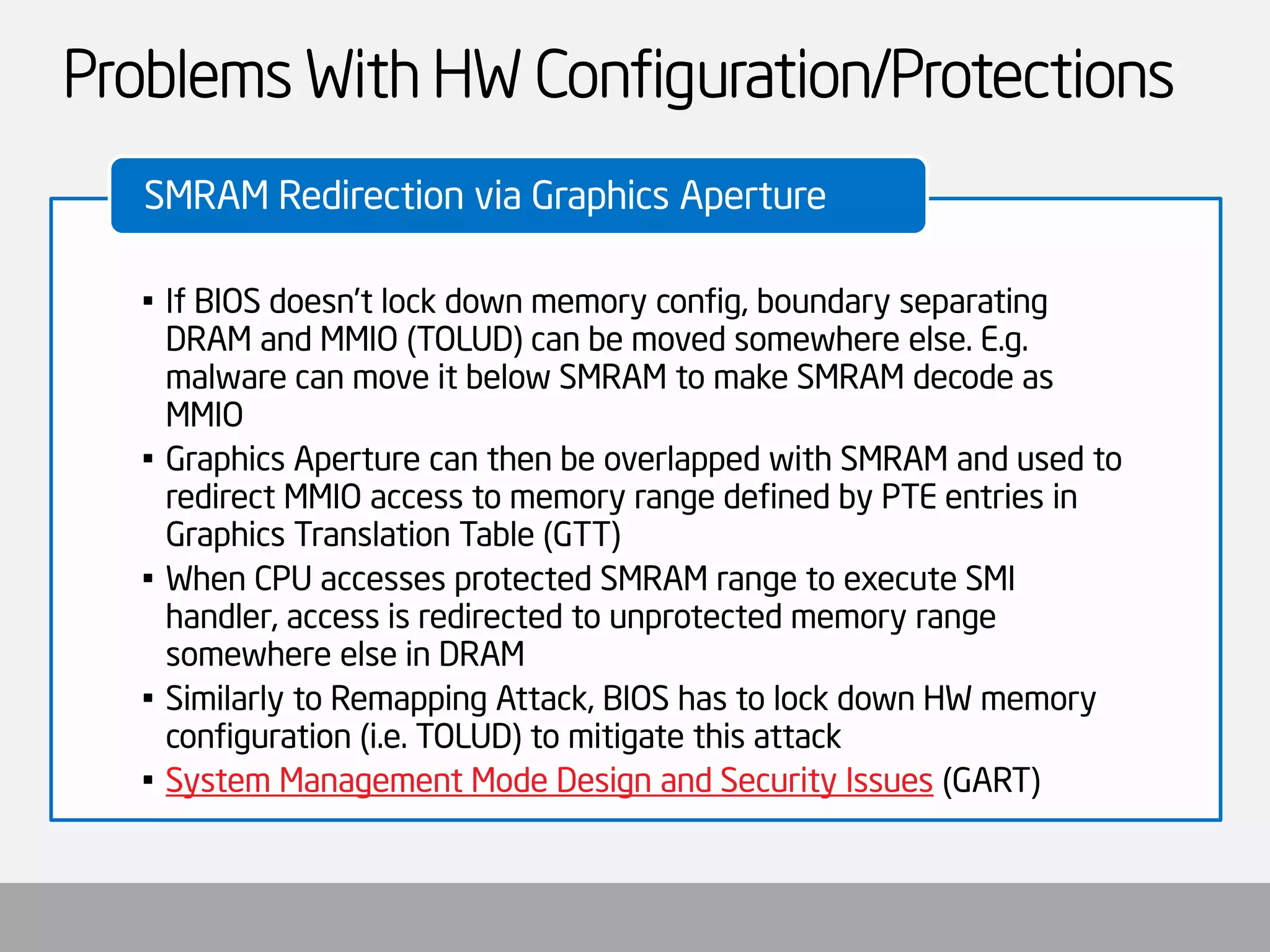
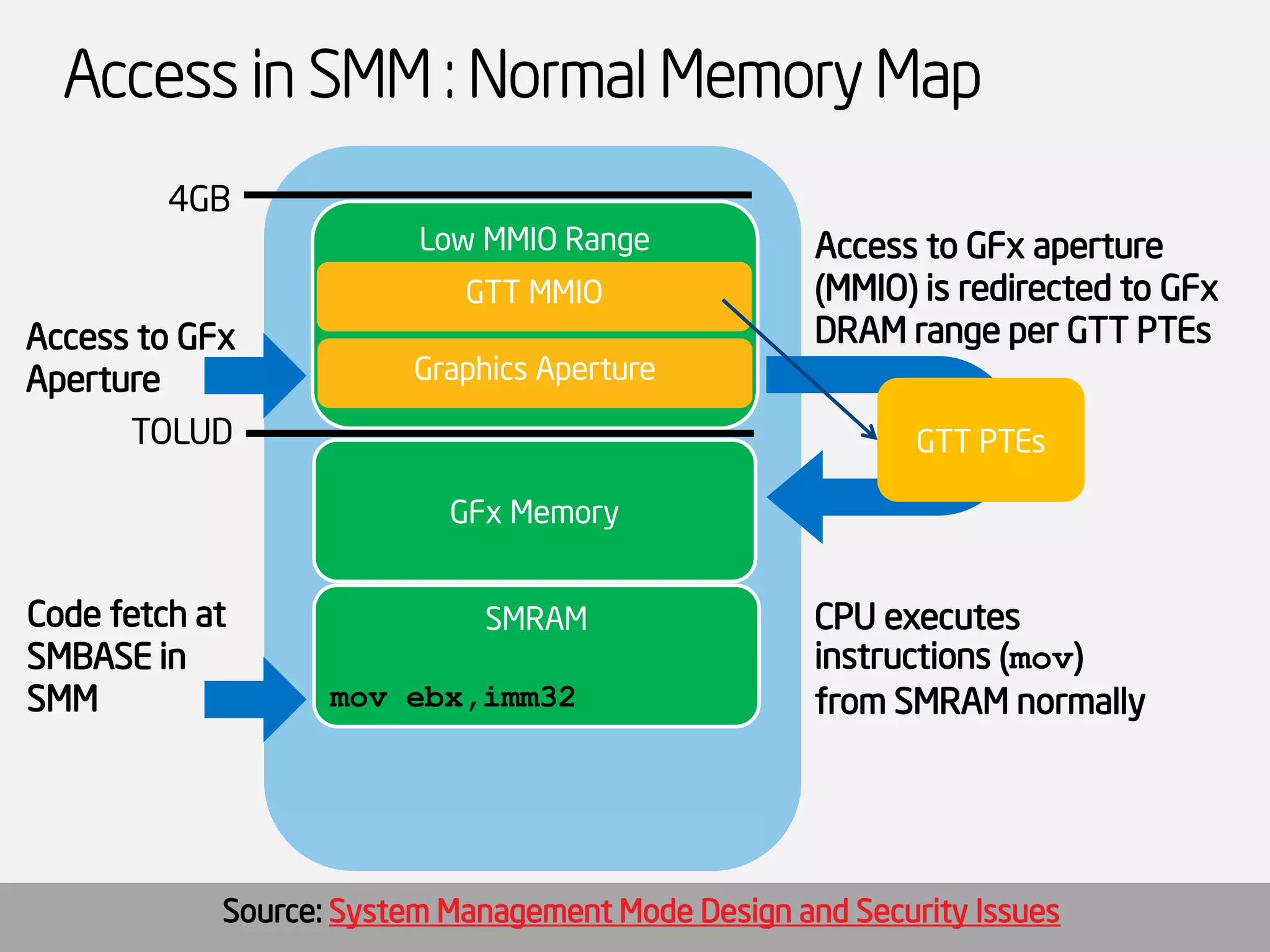
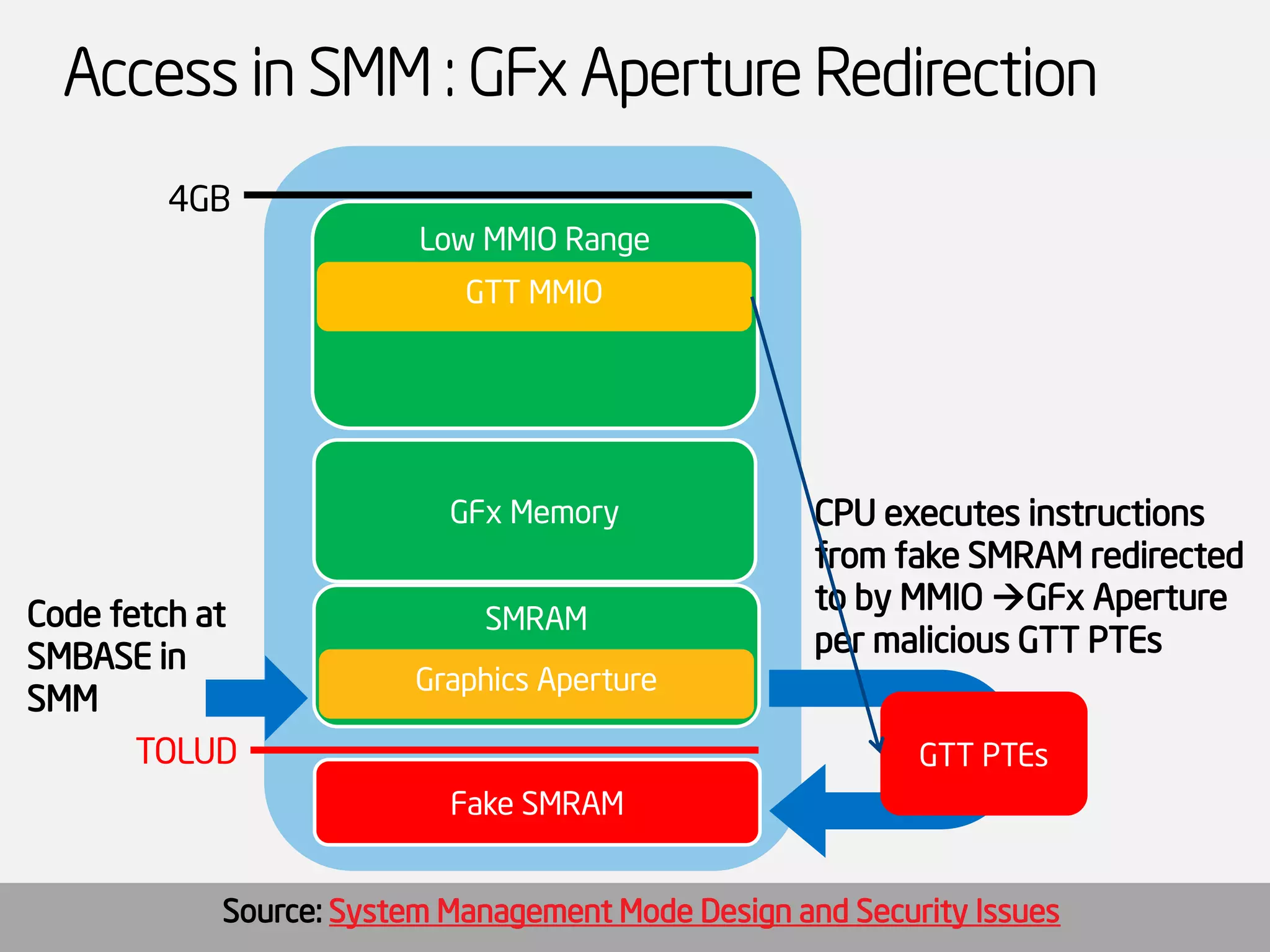

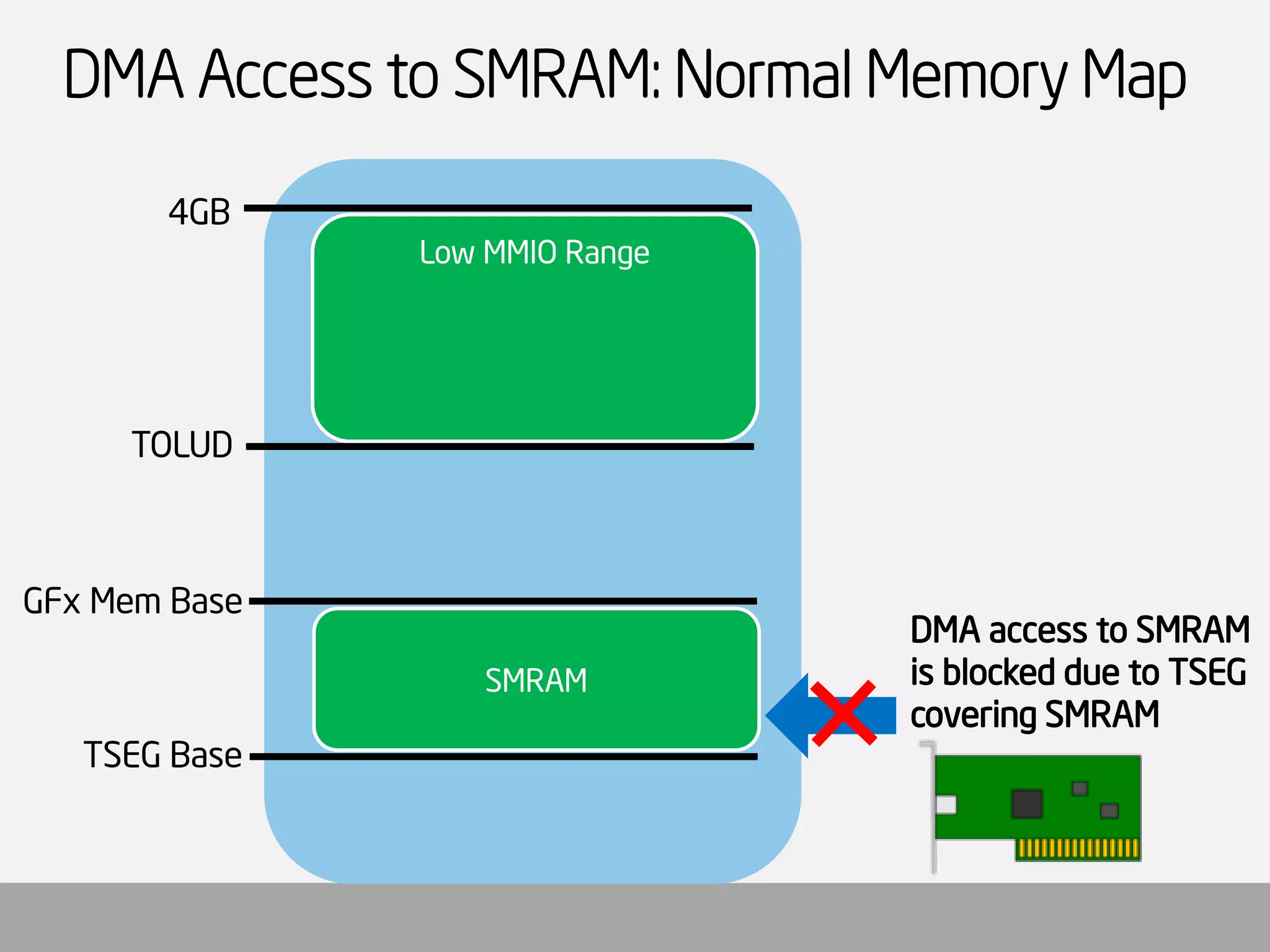

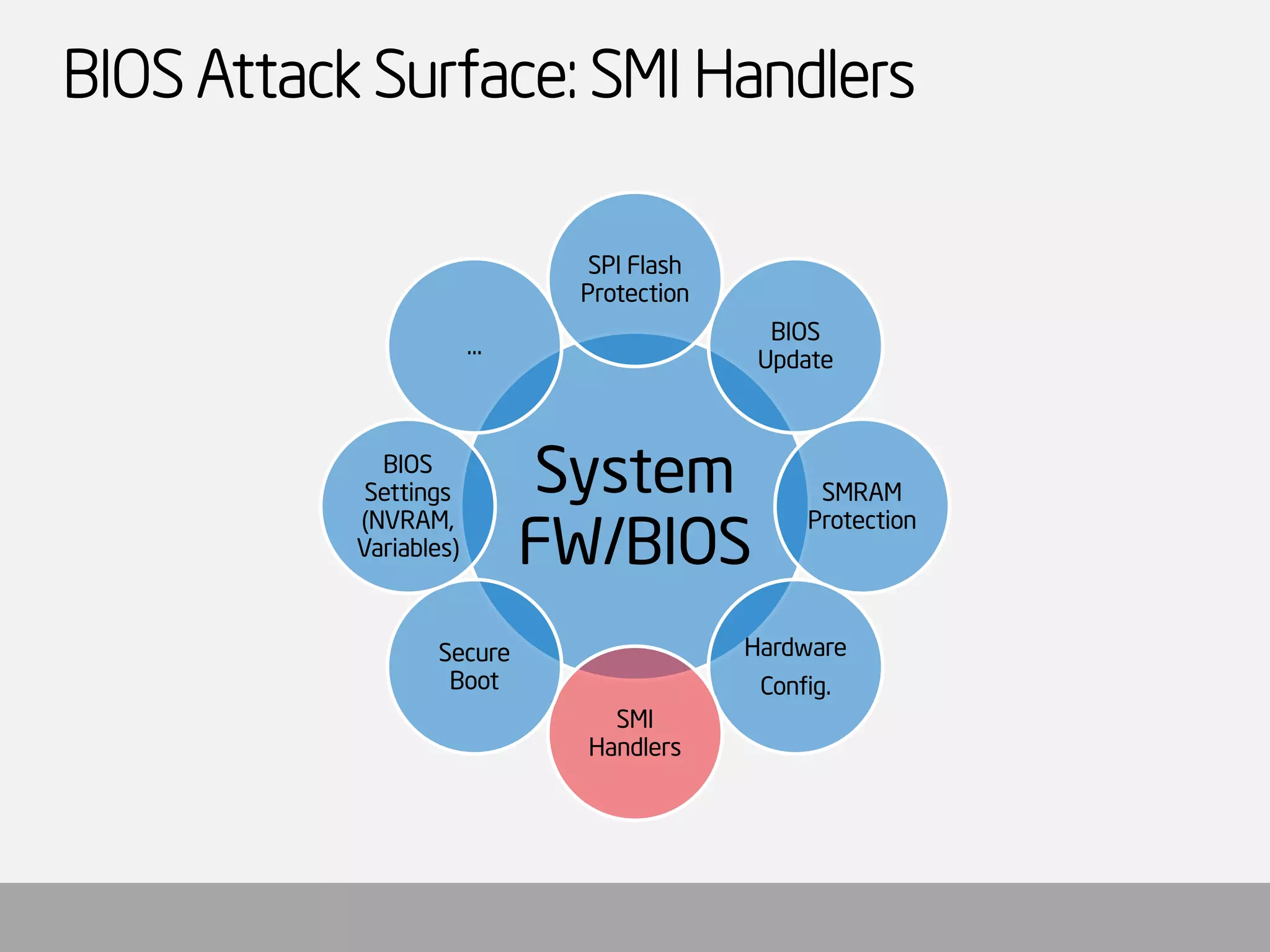
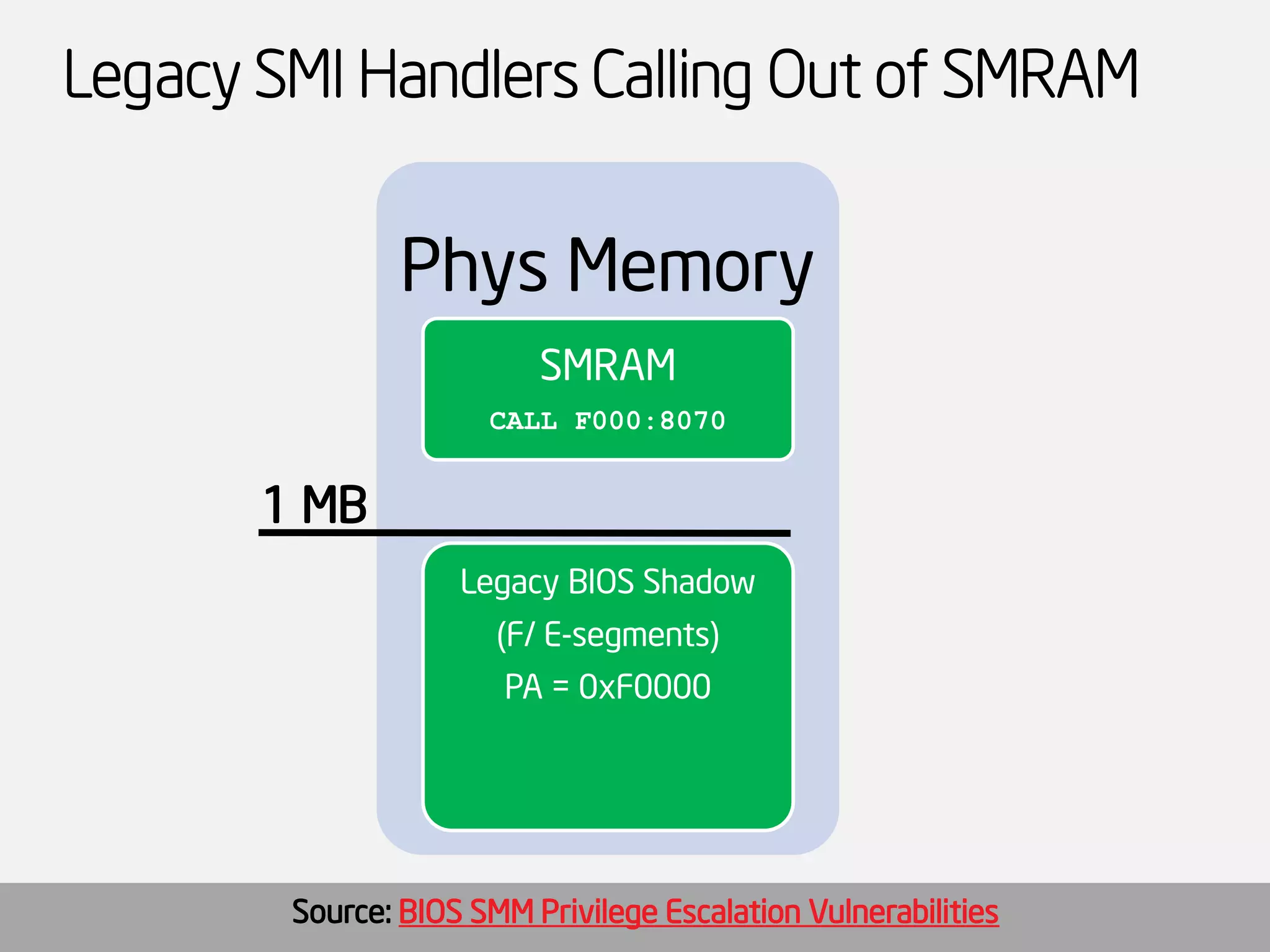
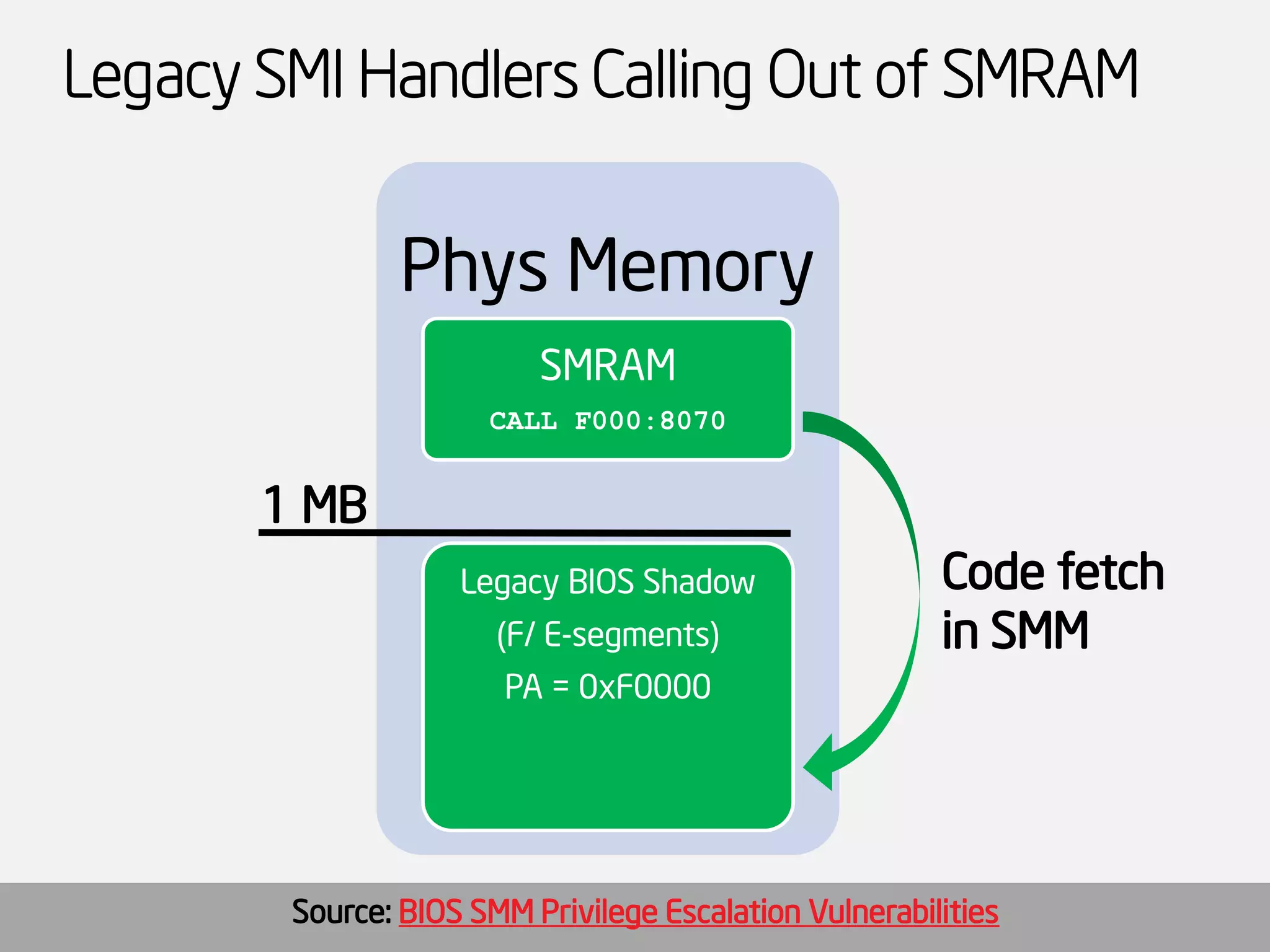

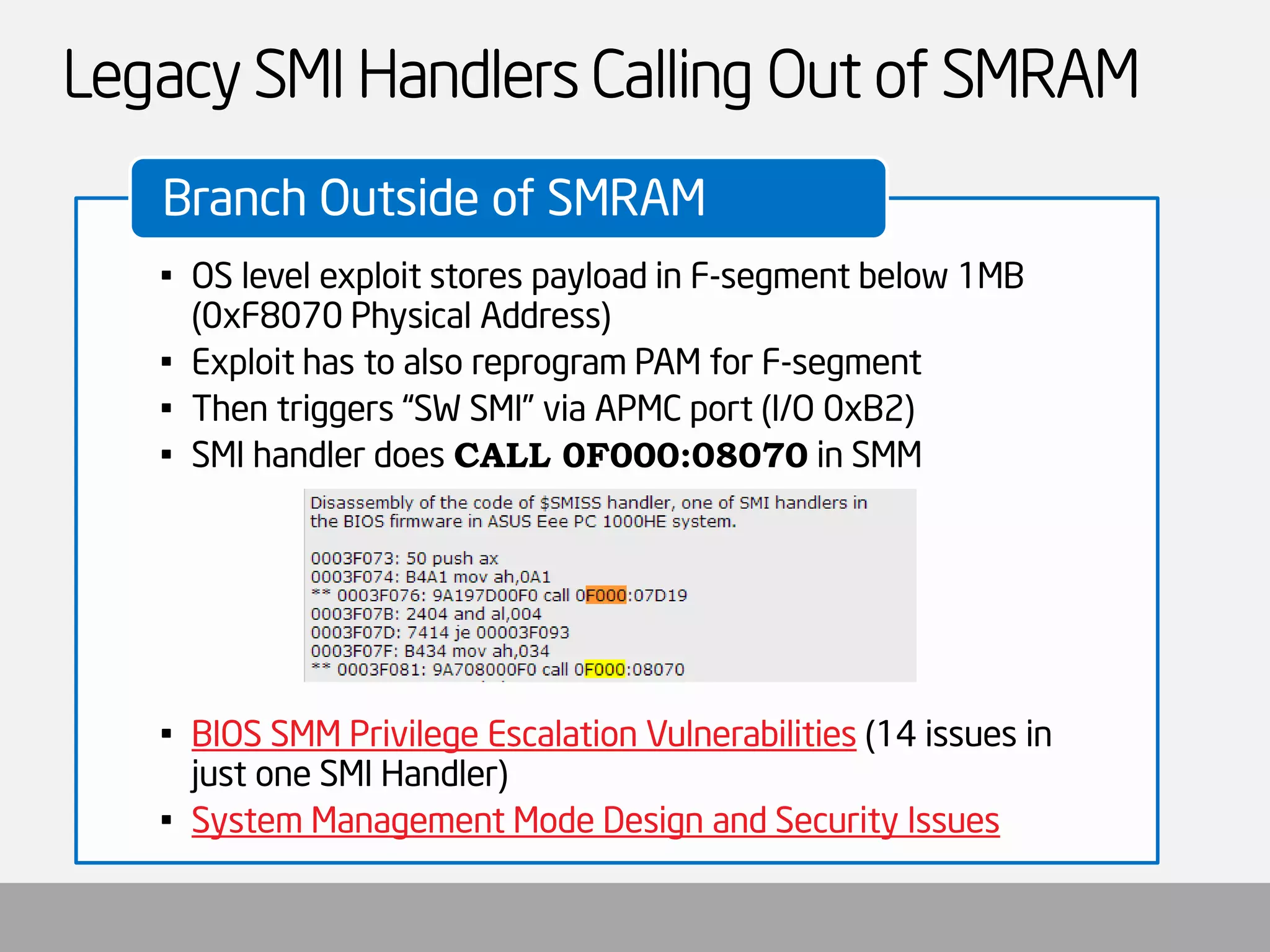
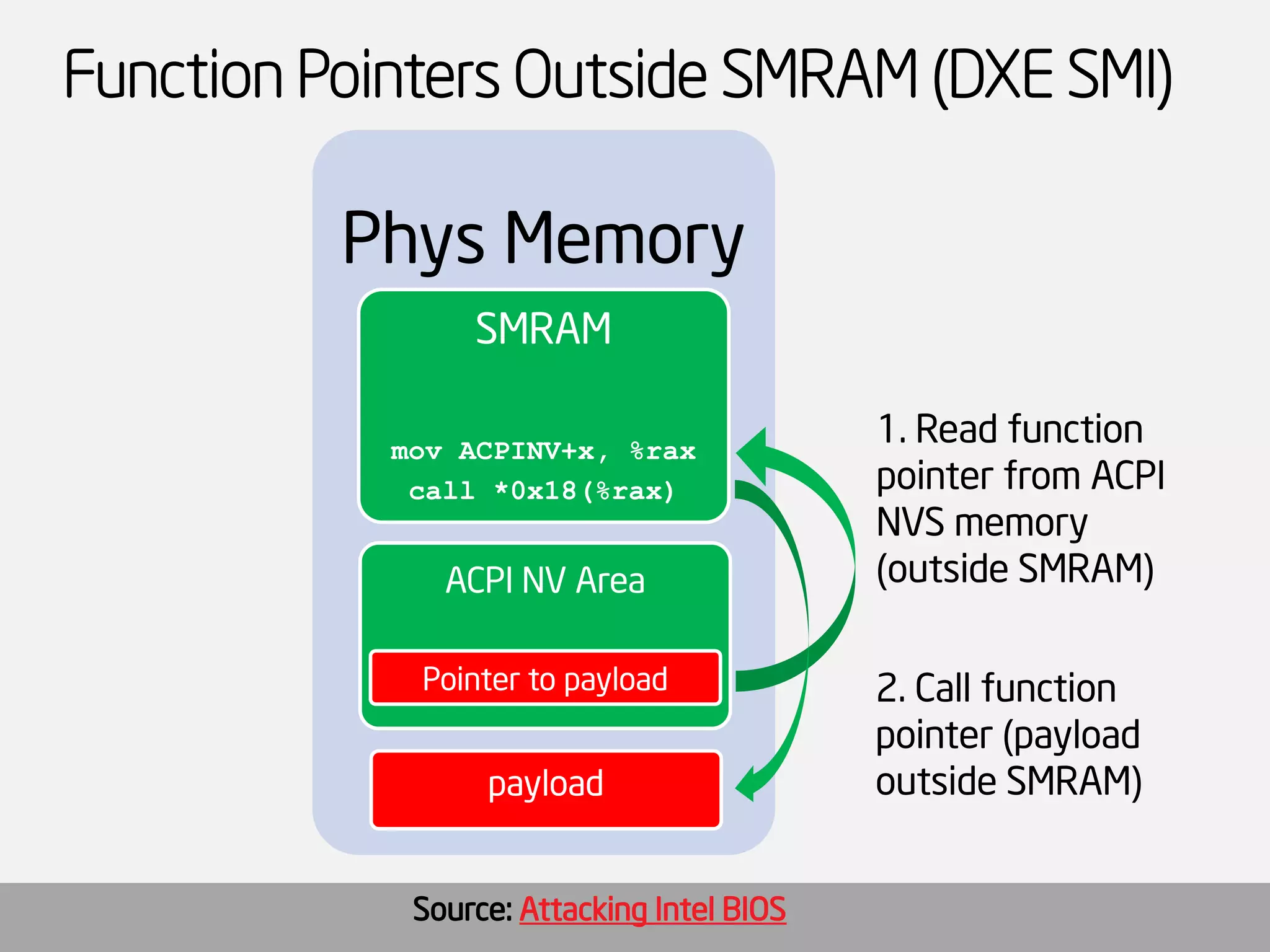
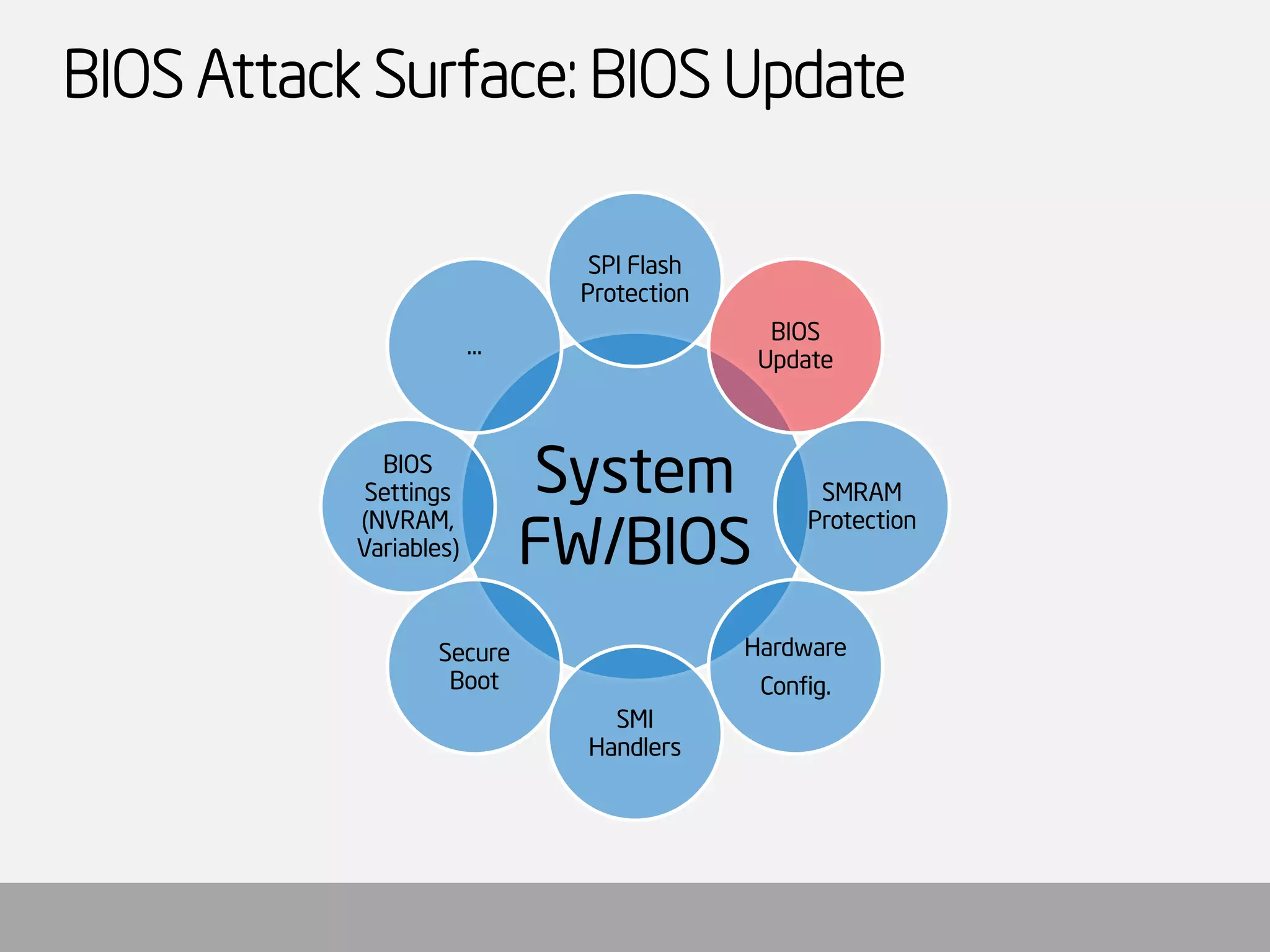
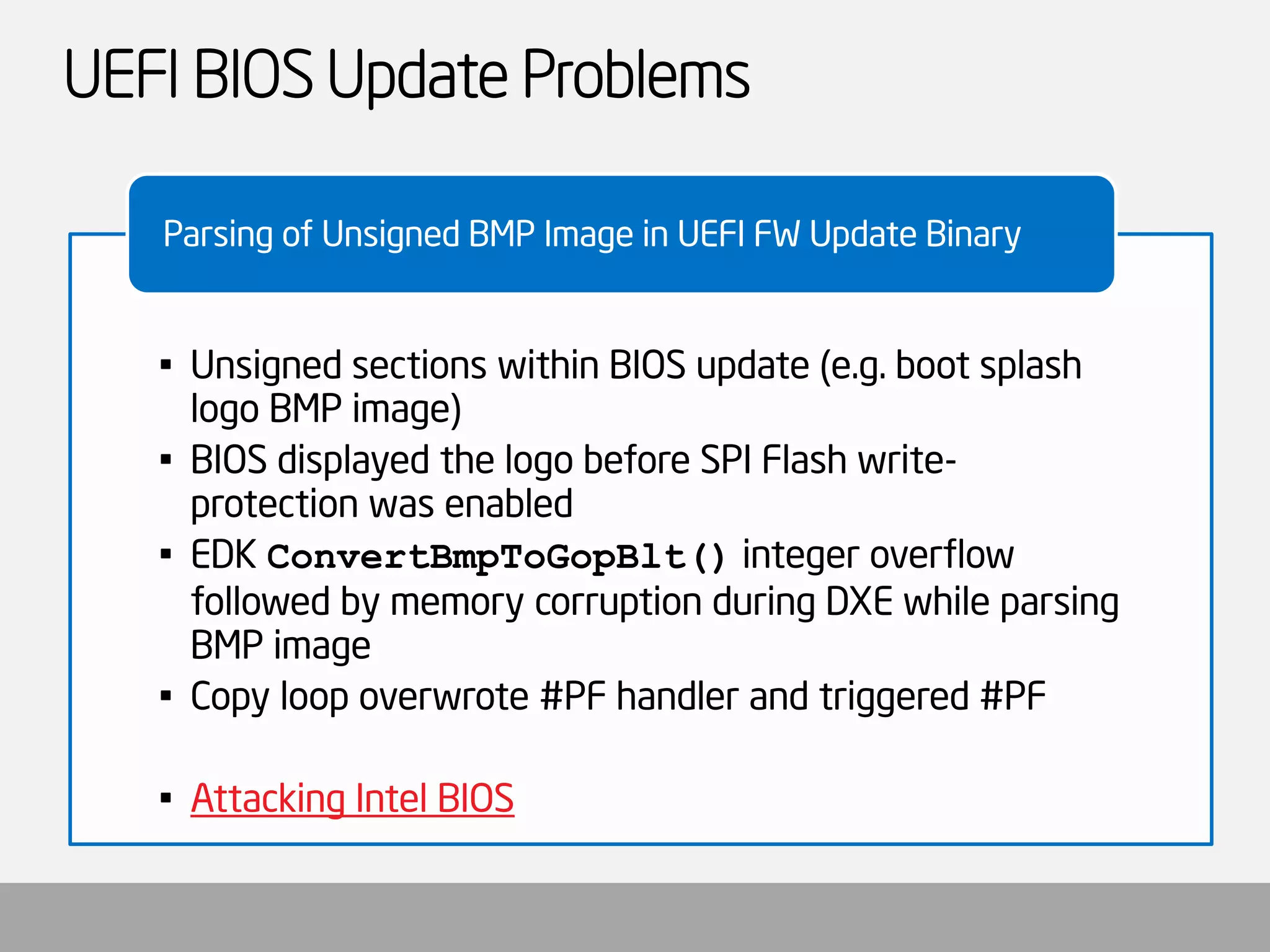
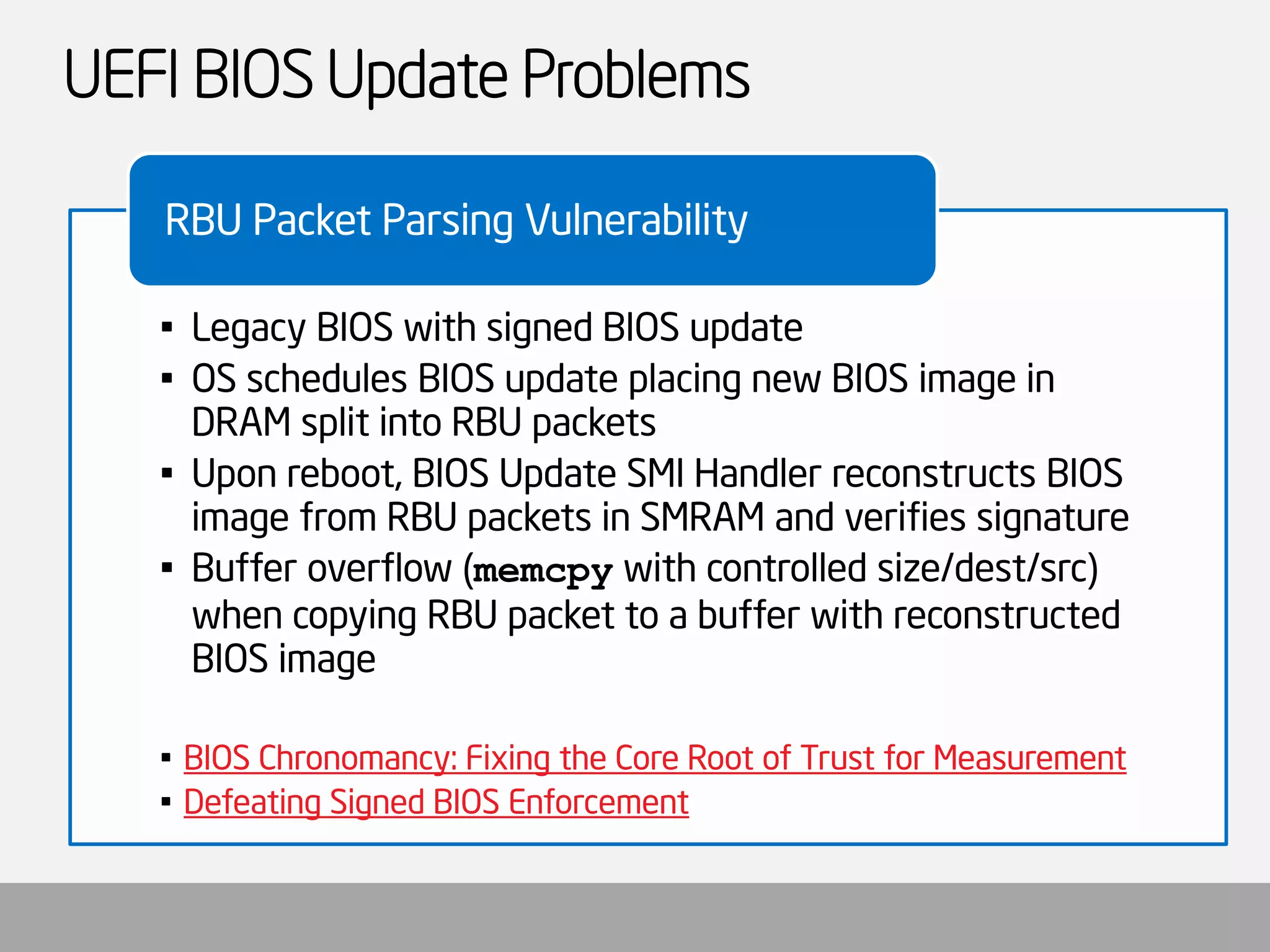
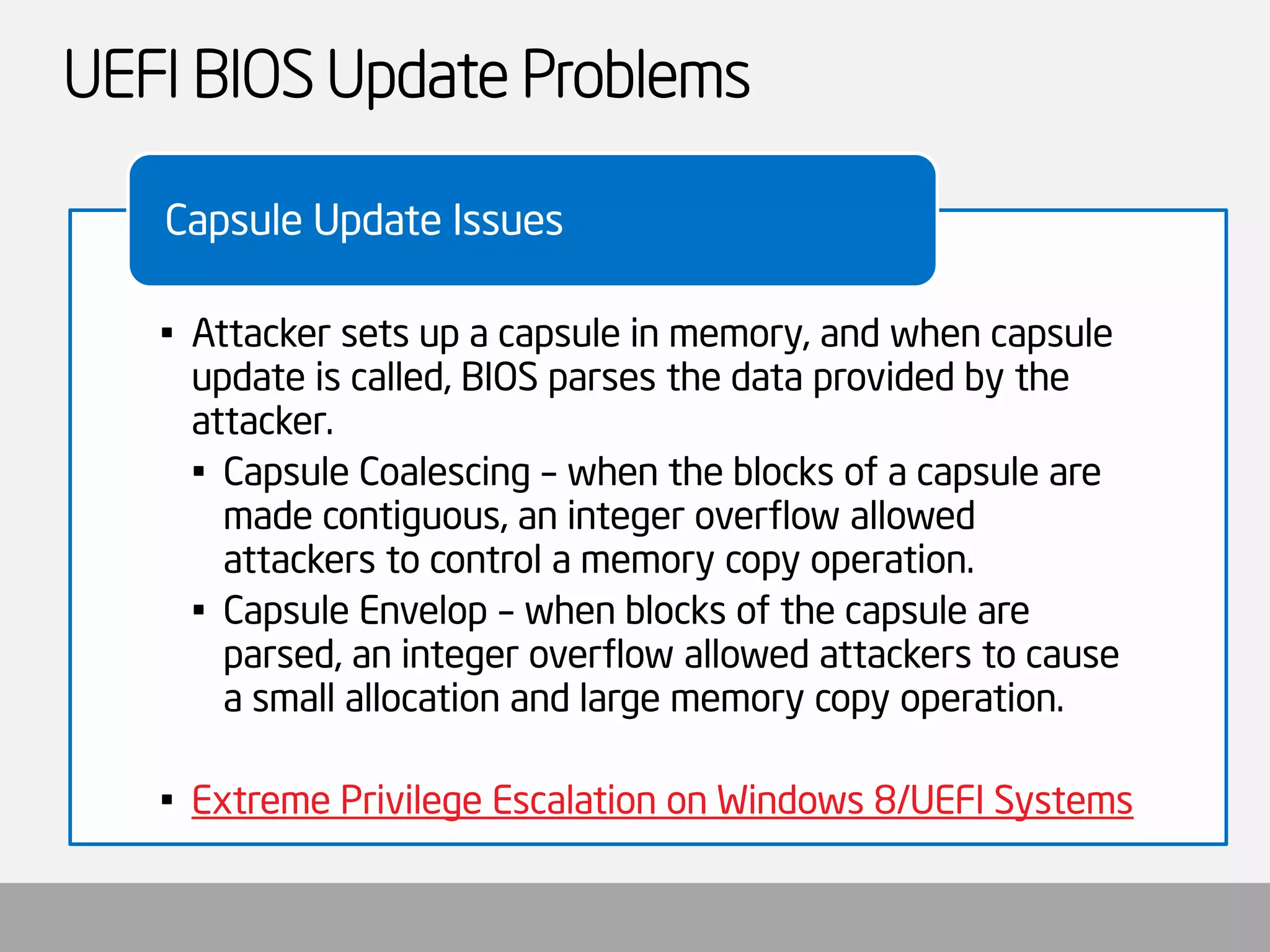

![Problems With HW Configuration/Protections
•“Top Swap” mode allows fault-tolerant update of the BIOS boot-block
•Enabled by BUC[TS] in Root Complex MMIO range
•Chipset inverts A16 line (A16-A20 depending on the size of boot-block) of the address targeting ROM, e.g. when CPU fetches reset vector on reboot
•Thus CPU executes from 0xFFFEFFF0 inside “backup” boot-block rather than from 0xFFFFFFF0
•Top Swap indicator is not reset on reboot (requires RTC reset)
•When not locked/protected, malware can redirect execution of reset vector to alternate (backup) boot-block
•BIOS Boot Hijacking and VMware Vulnerabilities Digging
•BIOS has to lock down Top Swap configuration (BIOS Interface Lock in General Control & Status register) & protect swap boot-block range in SPI
•chipsec_main--module common.bios_ts
BIOS Top Boot-Block Swap Attack](https://image.slidesharecdn.com/biosandsecurebootattacksuncoveredeko10-141213185452-conversion-gate01/75/BIOS-and-Secure-Boot-Attacks-Uncovered-72-2048.jpg)
![BIOS Top Boot-Block Swap Attack
Original BIOS Boot-Block
0xFFFFFFF0
CPU normally fetches reset vector at FFFFFFF0
0xFFFEFFF0
Alternate BIOS Boot-Block
(BUC[TS] = 1)
When TS is not locked:
•Malware sets BUC[TS]
•Out of reset, CPU starts @ reset vector
•Chipset inverts A16
•CPU fetches instr. from alternate BB (at FFFEFFF0) instead of FFFFFFF0
Source: BIOS Boot Hijacking and VMware Vulnerabilities Digging](https://image.slidesharecdn.com/biosandsecurebootattacksuncoveredeko10-141213185452-conversion-gate01/75/BIOS-and-Secure-Boot-Attacks-Uncovered-73-2048.jpg)
